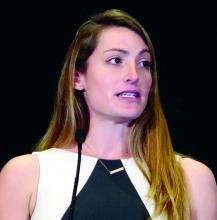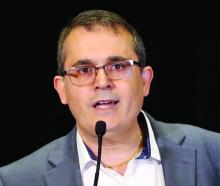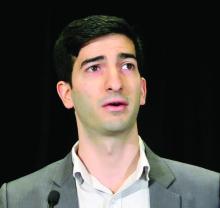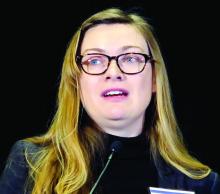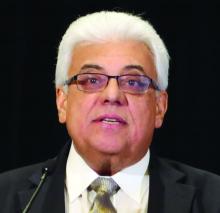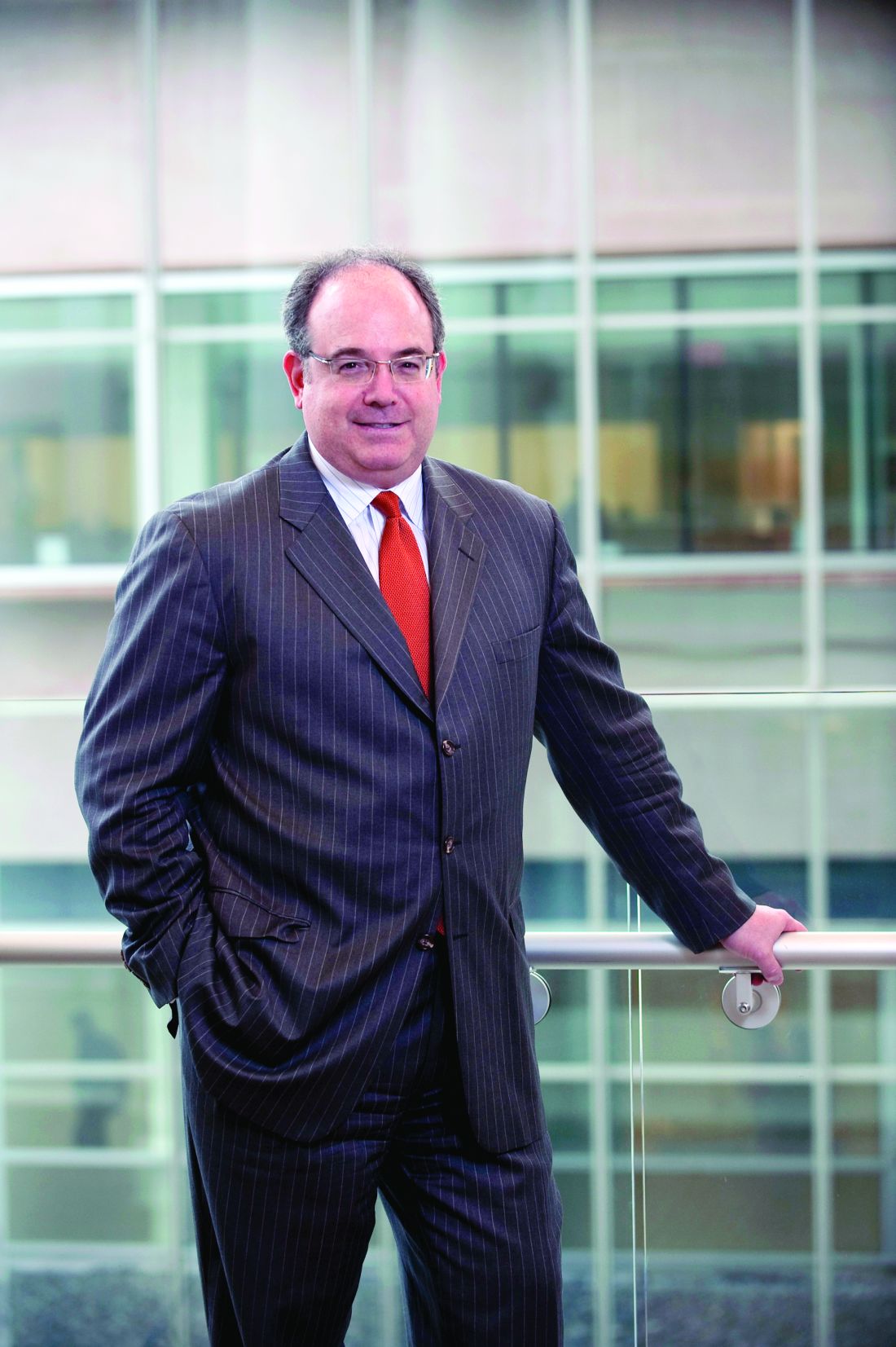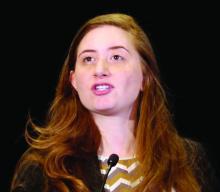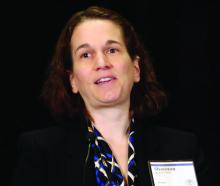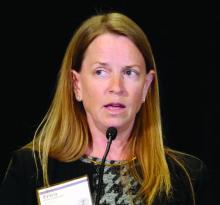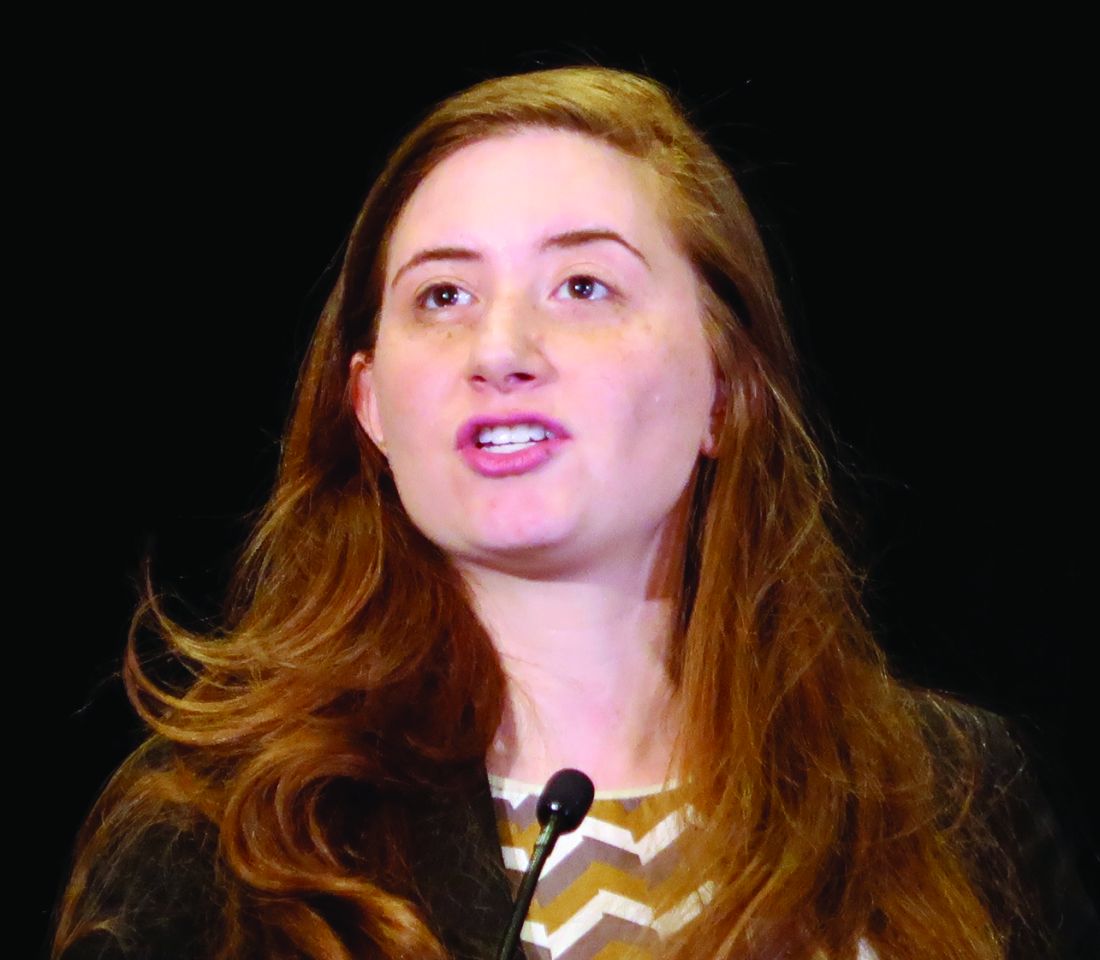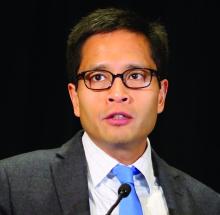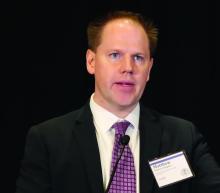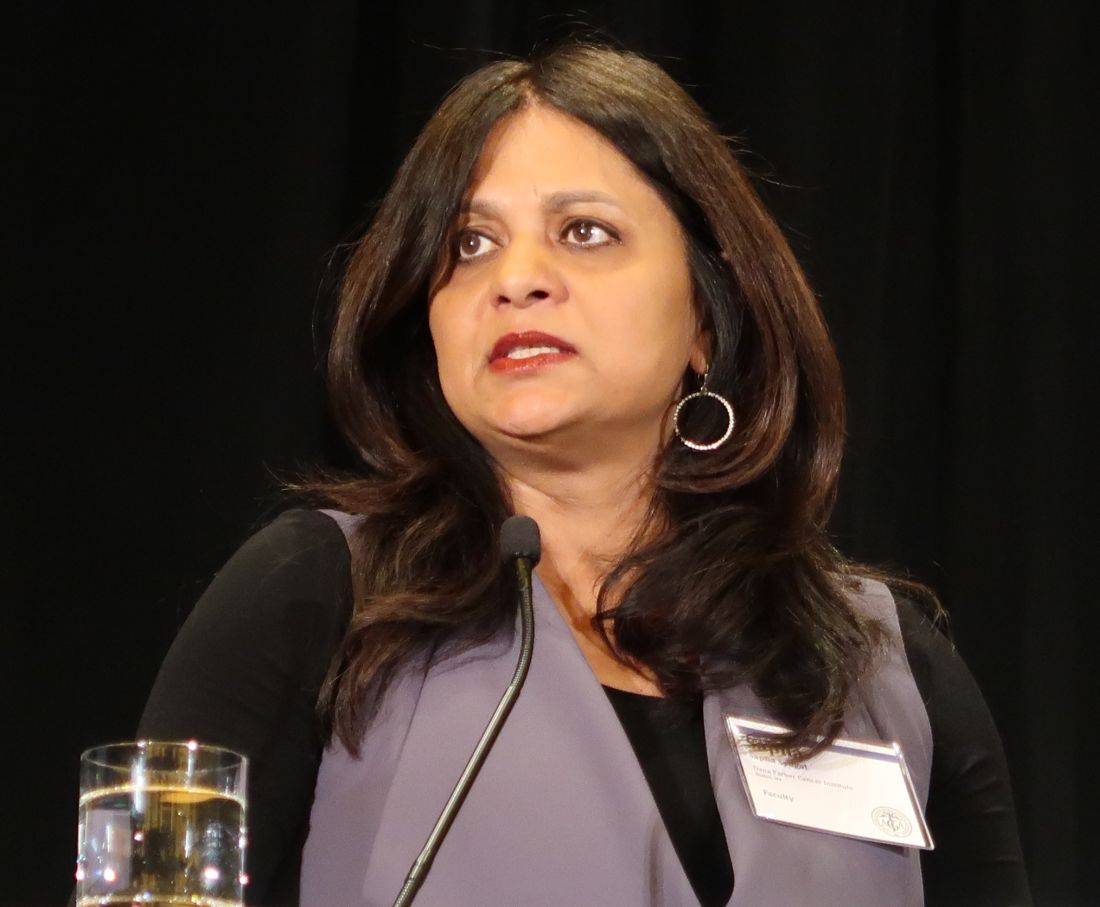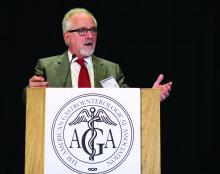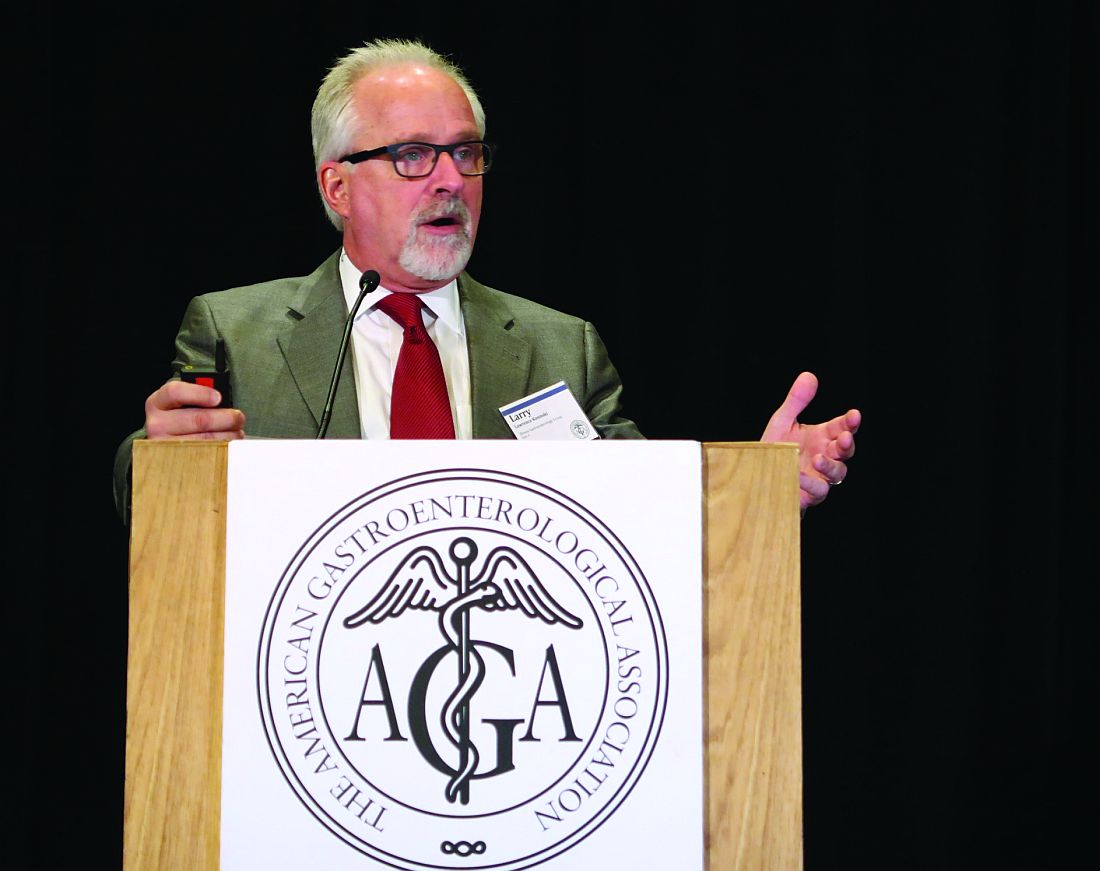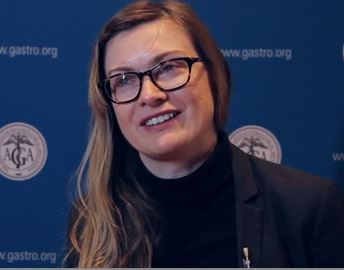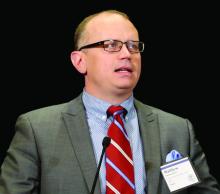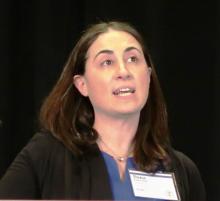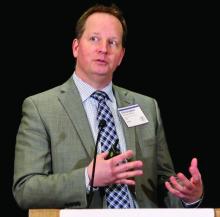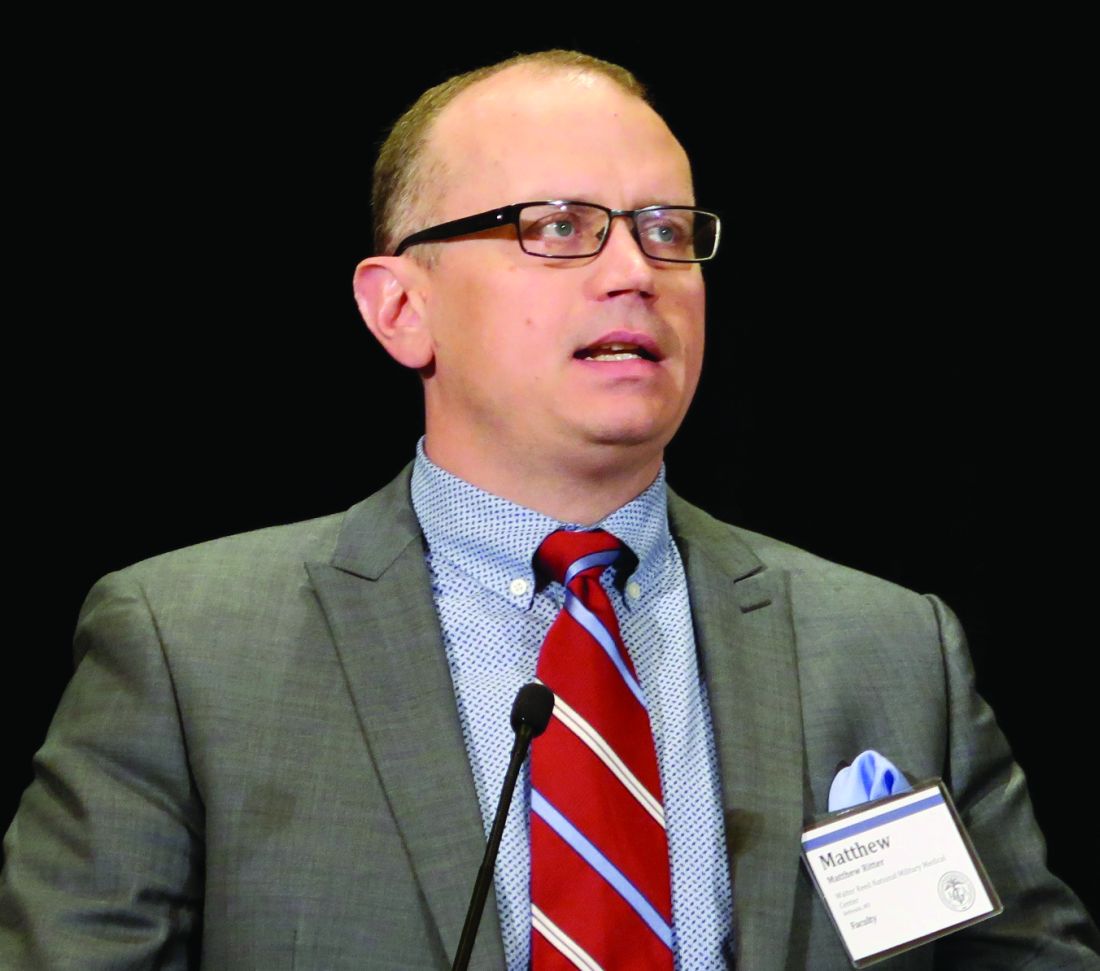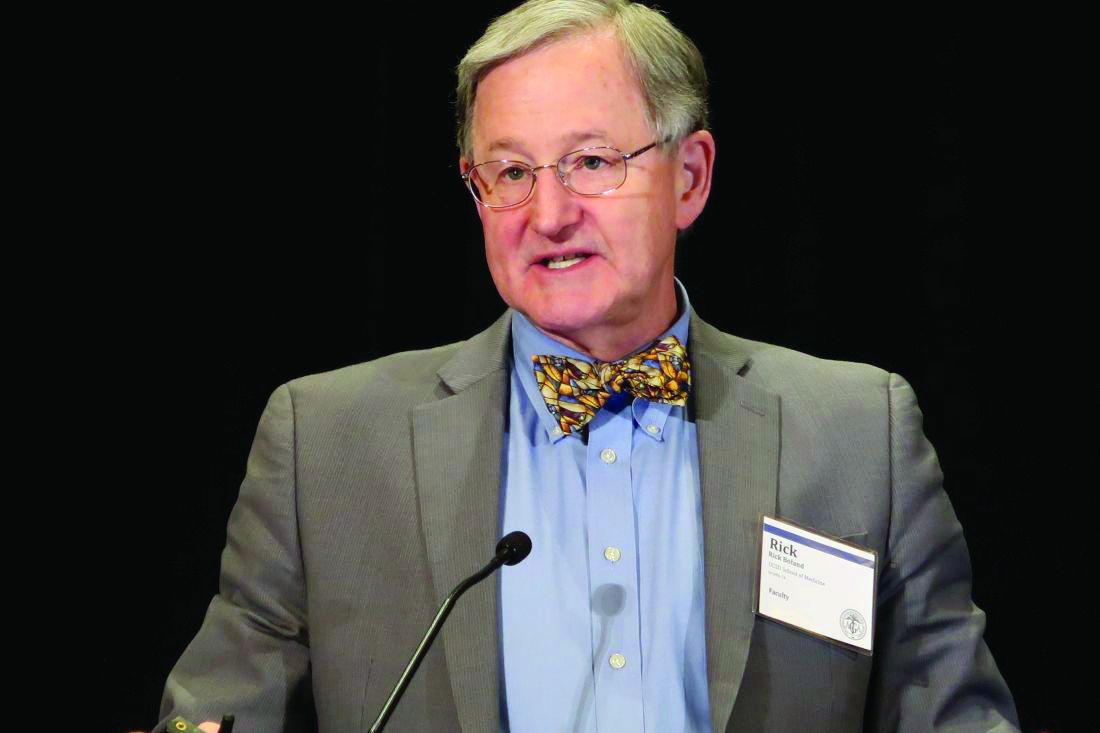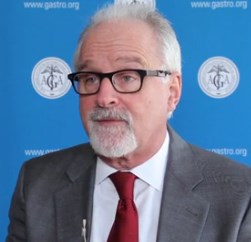User login
New leaders to take over helm of AGA’s innovation center
BOSTON – Both the soon-to-be chair and vice chair of the AGA Center for GI Innovation and Technology, which sponsors the AGA Tech Summit, are looking forward to building upon the successes of this year’s meeting.
“Giving folks a road map and seeing physicians come to the meeting to network and meet the right people, that is the really satisfying part for me,” V. Raman Muthusamy, MD, the incoming chair of the committee, said in an interview.
“I was honored to be asked to take over this position,” he said. “I have been contemplating . . .where we are and where we’ve been and where we need to go next.”
Dr. Muthusamy, director of interventional endoscopy and general GI endoscopy and current professor of medicine at the University of California, Los Angeles, is keenly interested in the intersection of technical innovation and gastroenterology, especially concerning endoscopic technology.
The committee’s incoming vice chair, Srinadh Komanduri, MD, of Northwestern University’s Feinberg School of Medicine, Chicago, takes a deep interest in innovative medical technologies that are applicable to gastroenterology. “A lot of what I’m doing at Northwestern is cutting-edge techniques and looking for new innovation, especially for early cancers in the GI tract,” Dr. Komanduri said.
Dr. Muthusamy and Dr. Komanduri will assume their new roles June 1 when Michael L. Kochman, MD, AGAF, of the University of Pennsylvania, Philadelphia, retires from his position as executive chairman of the committee, shortly after the close of this year’s AGA Tech Summit. “It’s been an honor and humbling to have been entrusted with running the CGIT over the past term; we solidified a number of critical relationships and added new programs. I am thrilled that Raman and Sri will be taking the reins as the plans that they have will build on the foundation and take the CGIT to a new level.”
The meeting, according to the incoming chairs, offers a great opportunity for physician-innovators to share their interests and ideas.
“The Tech Summit is unlike any other meeting I’ve gone to. It is a time to see the business of science and the gaps in technology as well as the technicalities of business that are not part of the standard medical training,” said Dr. Muthusamy, who moderated this year’s “Shark Tank” session, considered the highlight event of the meeting during which entrepreneurs present their ideas to a panel of doctors and business leaders to gain a diverse range of insight on how to take their projects to the next level.
Learn more about the AGA Center for GI Innovation and Technology at www.gastro.org/CGIT.
[email protected]
On Twitter @EAZTweets
BOSTON – Both the soon-to-be chair and vice chair of the AGA Center for GI Innovation and Technology, which sponsors the AGA Tech Summit, are looking forward to building upon the successes of this year’s meeting.
“Giving folks a road map and seeing physicians come to the meeting to network and meet the right people, that is the really satisfying part for me,” V. Raman Muthusamy, MD, the incoming chair of the committee, said in an interview.
“I was honored to be asked to take over this position,” he said. “I have been contemplating . . .where we are and where we’ve been and where we need to go next.”
Dr. Muthusamy, director of interventional endoscopy and general GI endoscopy and current professor of medicine at the University of California, Los Angeles, is keenly interested in the intersection of technical innovation and gastroenterology, especially concerning endoscopic technology.
The committee’s incoming vice chair, Srinadh Komanduri, MD, of Northwestern University’s Feinberg School of Medicine, Chicago, takes a deep interest in innovative medical technologies that are applicable to gastroenterology. “A lot of what I’m doing at Northwestern is cutting-edge techniques and looking for new innovation, especially for early cancers in the GI tract,” Dr. Komanduri said.
Dr. Muthusamy and Dr. Komanduri will assume their new roles June 1 when Michael L. Kochman, MD, AGAF, of the University of Pennsylvania, Philadelphia, retires from his position as executive chairman of the committee, shortly after the close of this year’s AGA Tech Summit. “It’s been an honor and humbling to have been entrusted with running the CGIT over the past term; we solidified a number of critical relationships and added new programs. I am thrilled that Raman and Sri will be taking the reins as the plans that they have will build on the foundation and take the CGIT to a new level.”
The meeting, according to the incoming chairs, offers a great opportunity for physician-innovators to share their interests and ideas.
“The Tech Summit is unlike any other meeting I’ve gone to. It is a time to see the business of science and the gaps in technology as well as the technicalities of business that are not part of the standard medical training,” said Dr. Muthusamy, who moderated this year’s “Shark Tank” session, considered the highlight event of the meeting during which entrepreneurs present their ideas to a panel of doctors and business leaders to gain a diverse range of insight on how to take their projects to the next level.
Learn more about the AGA Center for GI Innovation and Technology at www.gastro.org/CGIT.
[email protected]
On Twitter @EAZTweets
BOSTON – Both the soon-to-be chair and vice chair of the AGA Center for GI Innovation and Technology, which sponsors the AGA Tech Summit, are looking forward to building upon the successes of this year’s meeting.
“Giving folks a road map and seeing physicians come to the meeting to network and meet the right people, that is the really satisfying part for me,” V. Raman Muthusamy, MD, the incoming chair of the committee, said in an interview.
“I was honored to be asked to take over this position,” he said. “I have been contemplating . . .where we are and where we’ve been and where we need to go next.”
Dr. Muthusamy, director of interventional endoscopy and general GI endoscopy and current professor of medicine at the University of California, Los Angeles, is keenly interested in the intersection of technical innovation and gastroenterology, especially concerning endoscopic technology.
The committee’s incoming vice chair, Srinadh Komanduri, MD, of Northwestern University’s Feinberg School of Medicine, Chicago, takes a deep interest in innovative medical technologies that are applicable to gastroenterology. “A lot of what I’m doing at Northwestern is cutting-edge techniques and looking for new innovation, especially for early cancers in the GI tract,” Dr. Komanduri said.
Dr. Muthusamy and Dr. Komanduri will assume their new roles June 1 when Michael L. Kochman, MD, AGAF, of the University of Pennsylvania, Philadelphia, retires from his position as executive chairman of the committee, shortly after the close of this year’s AGA Tech Summit. “It’s been an honor and humbling to have been entrusted with running the CGIT over the past term; we solidified a number of critical relationships and added new programs. I am thrilled that Raman and Sri will be taking the reins as the plans that they have will build on the foundation and take the CGIT to a new level.”
The meeting, according to the incoming chairs, offers a great opportunity for physician-innovators to share their interests and ideas.
“The Tech Summit is unlike any other meeting I’ve gone to. It is a time to see the business of science and the gaps in technology as well as the technicalities of business that are not part of the standard medical training,” said Dr. Muthusamy, who moderated this year’s “Shark Tank” session, considered the highlight event of the meeting during which entrepreneurs present their ideas to a panel of doctors and business leaders to gain a diverse range of insight on how to take their projects to the next level.
Learn more about the AGA Center for GI Innovation and Technology at www.gastro.org/CGIT.
[email protected]
On Twitter @EAZTweets
Shark Tank returns: Which GI innovations will make it to market?
BOSTON – A group of aspiring innovators appeared before a panel of experts at the 2017 AGA Tech Summit Shark Tank event to make the case for how their novel device or technology could help advance the field of gastroenterology.
“The conversation that occurs here is really the start of other conversations we hope will continue out of this room and into the future to help everyone move their device or concept forward,” Michael L. Kochman, MD, AGAF, chair of the AGA Center for GI Innovation and Technology (CGIT), which sponsors the summit, told the assembled audience of potential investors, regulatory officials, and other innovators. Dr. Kochman also served as one of the “sharks” who sought to ask fundamental questions and identify potential gaps in each business plan in an ultimate attempt to make the product better and market ready. He was joined by V. Raman Muthusamy, MD, CGIT’s incoming chair, and director of interventional endoscopy and general GI endoscopy at the University of California, Los Angeles, where he is also clinical professor of medicine in the division of digestive diseases. The panel also included Jeffrey M. Marks, MD, director of surgical endoscopy at University Hospitals Cleveland Medical Center, and Dennis McWilliams, president and chief commercial officer of Apollo Endosurgery, Inc.
Analyzing RNA biomarkers in stool samples
First to face the sharks was Erica Barnell, an MD/PhD candidate at the Washington University School of Medicine in St. Louis and the chief science officer of Geneoscopy, LLC. She and her collaborators have created a series of patent-pending methods to isolate and preserve neoplasia-associated RNA biomarkers in stool samples. The technology is expected to improve screening for colorectal cancer, which is the second leading cause of cancer-related deaths in the United States, with more than 50,000 deaths annually. The high mortality rate of colorectal cancer is due, in part, to flaws in existing methodologies to screen for the disease and because of a high rate of patient noncompliance with screening guidelines, according to Ms. Barnell.
Clinical data presented by Ms. Barnell showed that their predictive algorithms in a test population of 65 persons had 81% sensitivity and 59% specificity for detecting adenomas of all sizes. Ms. Barnell acknowledged that the specificity rate was not impressive, so she and her colleagues plan to add a fecal immunochemical test in their next round of clinical trial testing.
Among the feedback Ms. Barnell received was Dr. Kochman’s suggestion that geneoscopy would benefit from having strong head-to-head data for their novel screening procedure vs. current procedures to present to the U.S. Food and Drug Administration, which Ms. Barnell said she and her colleagues were already taking into account.
Reducing risk of repetitive motion injuries
Prosper Abitbol, MD, a gastroenterologist in private practice in Boca Raton, Fla., seeks to limit the potential for harm to the clinician who performs hundreds – or more – of colorectal screening procedures annually. The EndoFeed™ device Dr. Abitbol and his team brought to the Shark Tank panel practically eliminates the need for repetitive, coordinated wrist and thumb movements when performing a colonoscopy.
The EndoFeed™ drive mechanism moves the instruments through the channel of the endoscope’s insertion tube, making it easy to complete the necessary insertion and extraction motions in biopsies without injury from repetitive motion.
Dr. Abitbol and his team also presented the EndoReVu™, which he said increases polyp detection during screening through the use of a mirror that is inserted through the instrument channel of the scope, and then provides reflective images with existing endoscope optics. The mirror is flexible to ensure there is no damage to surrounding tissue. Both devices presented by Dr. Abitbol are single use and disposable.
He concluded his presentation to the panel by saying, “I spend most of my day in the endoscopy suite every day, and I know what I need to do a better job ... I see [what] the reactions of other doctors and nurses are to this product, and I have no doubt these two products will play a major role in the endoscopy suite.”
However, while Dr. Abitbol was commended for considering the problem of operator fatigue in colonoscopies – something at least one audience member said was too often overlooked – the panel unanimously agreed that for Dr. Abitbol to move his products forward he would need to conduct some rigorous studies to show conclusive data that they improve levels of fatigue.
Identifying, classifying small polyps during a procedure
A vexing problem for clinicians is what to do after detecting a colonic polyp, since the majority of those found are not precancerous. Now, Rizkullah “Ray” Dogum, an MS/MBA candidate, and his colleagues are seeking to market a technology that reads the information gathered by elastic scattering spectroscopy to determine whether a sample is dysplastic, essentially creating the first in vivo definitive polyp classification method.
“Using elastic scattering spectroscopy technology, polyps with negligible malignant potential are detected and classified during the procedure, circumventing the routine track to pathology labs,” Mr. Dogum explained in an interview, noting that this adds up to hundreds of millions of dollars savings per year. An important fact, he said, since as our population ages it requires more screening. “As much as $1 billion could be saved annually if diminutive polyps could simply be diagnosed, resected, and discarded in lieu of histopathological processing,” Mr. Dogum said.
Currently being tested in several clinical trials that so far are yielding what Mr. Dogum says are “promising” results, especially when compared with chromoendoscopy and narrow-band imaging, the patented technology uses a white light that is transmitted through fiber optic cables that are integrated into both the snare and forceps tools; the back-reflection is detected by a computer, making polyp classification possible.
An advantage in practice for using the technology is that it does not require any significant alteration in the current standard practice for colonoscopy and does not disrupt the standard flow of work, meaning there is less training required, according to Mr. Dogum.
An audience member who identified himself as a regulator with the FDA told Mr. Dogum that over the years the agency has “struggled” with how to classify imaging technologies, because they are tools, but do not actually change practice, noting that whether to resect and discard is a clinical decision made at the physician’s discretion, not one determined by a device. He expressed his skepticism that the product would qualify as a Class II device but did suggest that it might qualify as a low-risk, de novo product, something that Mr. Dogum said in an interview following the presentation that he and his collaborators would be interested in pursuing.
Preventing endoscopic retrograde infections
Mining Big Data for algorithms that can detect endoscopic infection clusters is what Susan Hutfless, PhD, an epidemiologist and assistant professor in the division of gastroenterology and hepatology at Johns Hopkins University in Baltimore, told the shark panel she and her collaborators want to do using Medicare and Medicaid claims.
“Using Medicare and Medicaid billing data, our technology identifies endoscopic errors in a succinct and quantitative way,” Dr. Hutfless said in an interview. She explained that this benefits device manufacturers, health care facilities, and insurers. Included on the as-yet unnamed software program’s dashboard are a range of metrics that allows continuous monitoring of care, risk factors, and sources of infection, all to prevent serious outbreaks and the proliferation of illness.
Dr. Hutfless and her team came upon the idea after a string of deadly endoscope-related infectious outbreaks were linked to closed-channel duodenoscopes.
“We think that our technology helps move the field forward, because it provides a solution to contain endoscopically transmitted infections without re-engineering the endoscope,” Dr. Hutfless said. “For instance, there was an outbreak despite the use of a redesigned scope. Our technology is able to identify gaps in the care pathway that include the endoscope itself as well as the possible human factors that may be playing a role.”
Another plus, she told the panel, is that the product would not require FDA approval.
Despite data Dr. Hutfless said she and her collaborators will be presenting later this year at the annual Digestive Disease Week(R) that show a tight correlation between relevant claims data and data collected by the FDA during the infection outbreaks, the panel concluded that the stronger marketing potential for this product would be as a monitoring system, not a predictive one, used in combination with an engineering solution.
Simplifying LED incorporation in scopes
LED is only the fourth lighting technology ever invented, according to Thomas V. Root, president and CEO of Acera Inc. In an interview, Mr. Root said that while LEDs are “overtaking all major lighting markets,” medical device manufacturers have been slow to catch on.
“Acera moves the industry ahead with its elliptical optic that significantly improves the collection efficiency and distribution of the LED light. This optic, provided in a modular assembly, simplifies incorporation of LEDs in the practice of scope design and manufacture,” he said.
By eliminating the light guide tether, the use of LED increases mobility and the potential for low-cost or even single-use devices, Mr. Root said. “The result is that engineers are liberated to reimagine how endoscopes are designed.”
Because half of fires that occur in the endoscopy setting come from malfunctioning light sources, one of the sharks suggested that since the Acera product does not use the infrared wavelengths in its light, and its electrical cord remains cool to the touch while in use, Mr. Root and his colleagues should highlight that as a unique safety feature in their marketing materials.
[email protected]
On Twitter @whitneymcknight
BOSTON – A group of aspiring innovators appeared before a panel of experts at the 2017 AGA Tech Summit Shark Tank event to make the case for how their novel device or technology could help advance the field of gastroenterology.
“The conversation that occurs here is really the start of other conversations we hope will continue out of this room and into the future to help everyone move their device or concept forward,” Michael L. Kochman, MD, AGAF, chair of the AGA Center for GI Innovation and Technology (CGIT), which sponsors the summit, told the assembled audience of potential investors, regulatory officials, and other innovators. Dr. Kochman also served as one of the “sharks” who sought to ask fundamental questions and identify potential gaps in each business plan in an ultimate attempt to make the product better and market ready. He was joined by V. Raman Muthusamy, MD, CGIT’s incoming chair, and director of interventional endoscopy and general GI endoscopy at the University of California, Los Angeles, where he is also clinical professor of medicine in the division of digestive diseases. The panel also included Jeffrey M. Marks, MD, director of surgical endoscopy at University Hospitals Cleveland Medical Center, and Dennis McWilliams, president and chief commercial officer of Apollo Endosurgery, Inc.
Analyzing RNA biomarkers in stool samples
First to face the sharks was Erica Barnell, an MD/PhD candidate at the Washington University School of Medicine in St. Louis and the chief science officer of Geneoscopy, LLC. She and her collaborators have created a series of patent-pending methods to isolate and preserve neoplasia-associated RNA biomarkers in stool samples. The technology is expected to improve screening for colorectal cancer, which is the second leading cause of cancer-related deaths in the United States, with more than 50,000 deaths annually. The high mortality rate of colorectal cancer is due, in part, to flaws in existing methodologies to screen for the disease and because of a high rate of patient noncompliance with screening guidelines, according to Ms. Barnell.
Clinical data presented by Ms. Barnell showed that their predictive algorithms in a test population of 65 persons had 81% sensitivity and 59% specificity for detecting adenomas of all sizes. Ms. Barnell acknowledged that the specificity rate was not impressive, so she and her colleagues plan to add a fecal immunochemical test in their next round of clinical trial testing.
Among the feedback Ms. Barnell received was Dr. Kochman’s suggestion that geneoscopy would benefit from having strong head-to-head data for their novel screening procedure vs. current procedures to present to the U.S. Food and Drug Administration, which Ms. Barnell said she and her colleagues were already taking into account.
Reducing risk of repetitive motion injuries
Prosper Abitbol, MD, a gastroenterologist in private practice in Boca Raton, Fla., seeks to limit the potential for harm to the clinician who performs hundreds – or more – of colorectal screening procedures annually. The EndoFeed™ device Dr. Abitbol and his team brought to the Shark Tank panel practically eliminates the need for repetitive, coordinated wrist and thumb movements when performing a colonoscopy.
The EndoFeed™ drive mechanism moves the instruments through the channel of the endoscope’s insertion tube, making it easy to complete the necessary insertion and extraction motions in biopsies without injury from repetitive motion.
Dr. Abitbol and his team also presented the EndoReVu™, which he said increases polyp detection during screening through the use of a mirror that is inserted through the instrument channel of the scope, and then provides reflective images with existing endoscope optics. The mirror is flexible to ensure there is no damage to surrounding tissue. Both devices presented by Dr. Abitbol are single use and disposable.
He concluded his presentation to the panel by saying, “I spend most of my day in the endoscopy suite every day, and I know what I need to do a better job ... I see [what] the reactions of other doctors and nurses are to this product, and I have no doubt these two products will play a major role in the endoscopy suite.”
However, while Dr. Abitbol was commended for considering the problem of operator fatigue in colonoscopies – something at least one audience member said was too often overlooked – the panel unanimously agreed that for Dr. Abitbol to move his products forward he would need to conduct some rigorous studies to show conclusive data that they improve levels of fatigue.
Identifying, classifying small polyps during a procedure
A vexing problem for clinicians is what to do after detecting a colonic polyp, since the majority of those found are not precancerous. Now, Rizkullah “Ray” Dogum, an MS/MBA candidate, and his colleagues are seeking to market a technology that reads the information gathered by elastic scattering spectroscopy to determine whether a sample is dysplastic, essentially creating the first in vivo definitive polyp classification method.
“Using elastic scattering spectroscopy technology, polyps with negligible malignant potential are detected and classified during the procedure, circumventing the routine track to pathology labs,” Mr. Dogum explained in an interview, noting that this adds up to hundreds of millions of dollars savings per year. An important fact, he said, since as our population ages it requires more screening. “As much as $1 billion could be saved annually if diminutive polyps could simply be diagnosed, resected, and discarded in lieu of histopathological processing,” Mr. Dogum said.
Currently being tested in several clinical trials that so far are yielding what Mr. Dogum says are “promising” results, especially when compared with chromoendoscopy and narrow-band imaging, the patented technology uses a white light that is transmitted through fiber optic cables that are integrated into both the snare and forceps tools; the back-reflection is detected by a computer, making polyp classification possible.
An advantage in practice for using the technology is that it does not require any significant alteration in the current standard practice for colonoscopy and does not disrupt the standard flow of work, meaning there is less training required, according to Mr. Dogum.
An audience member who identified himself as a regulator with the FDA told Mr. Dogum that over the years the agency has “struggled” with how to classify imaging technologies, because they are tools, but do not actually change practice, noting that whether to resect and discard is a clinical decision made at the physician’s discretion, not one determined by a device. He expressed his skepticism that the product would qualify as a Class II device but did suggest that it might qualify as a low-risk, de novo product, something that Mr. Dogum said in an interview following the presentation that he and his collaborators would be interested in pursuing.
Preventing endoscopic retrograde infections
Mining Big Data for algorithms that can detect endoscopic infection clusters is what Susan Hutfless, PhD, an epidemiologist and assistant professor in the division of gastroenterology and hepatology at Johns Hopkins University in Baltimore, told the shark panel she and her collaborators want to do using Medicare and Medicaid claims.
“Using Medicare and Medicaid billing data, our technology identifies endoscopic errors in a succinct and quantitative way,” Dr. Hutfless said in an interview. She explained that this benefits device manufacturers, health care facilities, and insurers. Included on the as-yet unnamed software program’s dashboard are a range of metrics that allows continuous monitoring of care, risk factors, and sources of infection, all to prevent serious outbreaks and the proliferation of illness.
Dr. Hutfless and her team came upon the idea after a string of deadly endoscope-related infectious outbreaks were linked to closed-channel duodenoscopes.
“We think that our technology helps move the field forward, because it provides a solution to contain endoscopically transmitted infections without re-engineering the endoscope,” Dr. Hutfless said. “For instance, there was an outbreak despite the use of a redesigned scope. Our technology is able to identify gaps in the care pathway that include the endoscope itself as well as the possible human factors that may be playing a role.”
Another plus, she told the panel, is that the product would not require FDA approval.
Despite data Dr. Hutfless said she and her collaborators will be presenting later this year at the annual Digestive Disease Week(R) that show a tight correlation between relevant claims data and data collected by the FDA during the infection outbreaks, the panel concluded that the stronger marketing potential for this product would be as a monitoring system, not a predictive one, used in combination with an engineering solution.
Simplifying LED incorporation in scopes
LED is only the fourth lighting technology ever invented, according to Thomas V. Root, president and CEO of Acera Inc. In an interview, Mr. Root said that while LEDs are “overtaking all major lighting markets,” medical device manufacturers have been slow to catch on.
“Acera moves the industry ahead with its elliptical optic that significantly improves the collection efficiency and distribution of the LED light. This optic, provided in a modular assembly, simplifies incorporation of LEDs in the practice of scope design and manufacture,” he said.
By eliminating the light guide tether, the use of LED increases mobility and the potential for low-cost or even single-use devices, Mr. Root said. “The result is that engineers are liberated to reimagine how endoscopes are designed.”
Because half of fires that occur in the endoscopy setting come from malfunctioning light sources, one of the sharks suggested that since the Acera product does not use the infrared wavelengths in its light, and its electrical cord remains cool to the touch while in use, Mr. Root and his colleagues should highlight that as a unique safety feature in their marketing materials.
[email protected]
On Twitter @whitneymcknight
BOSTON – A group of aspiring innovators appeared before a panel of experts at the 2017 AGA Tech Summit Shark Tank event to make the case for how their novel device or technology could help advance the field of gastroenterology.
“The conversation that occurs here is really the start of other conversations we hope will continue out of this room and into the future to help everyone move their device or concept forward,” Michael L. Kochman, MD, AGAF, chair of the AGA Center for GI Innovation and Technology (CGIT), which sponsors the summit, told the assembled audience of potential investors, regulatory officials, and other innovators. Dr. Kochman also served as one of the “sharks” who sought to ask fundamental questions and identify potential gaps in each business plan in an ultimate attempt to make the product better and market ready. He was joined by V. Raman Muthusamy, MD, CGIT’s incoming chair, and director of interventional endoscopy and general GI endoscopy at the University of California, Los Angeles, where he is also clinical professor of medicine in the division of digestive diseases. The panel also included Jeffrey M. Marks, MD, director of surgical endoscopy at University Hospitals Cleveland Medical Center, and Dennis McWilliams, president and chief commercial officer of Apollo Endosurgery, Inc.
Analyzing RNA biomarkers in stool samples
First to face the sharks was Erica Barnell, an MD/PhD candidate at the Washington University School of Medicine in St. Louis and the chief science officer of Geneoscopy, LLC. She and her collaborators have created a series of patent-pending methods to isolate and preserve neoplasia-associated RNA biomarkers in stool samples. The technology is expected to improve screening for colorectal cancer, which is the second leading cause of cancer-related deaths in the United States, with more than 50,000 deaths annually. The high mortality rate of colorectal cancer is due, in part, to flaws in existing methodologies to screen for the disease and because of a high rate of patient noncompliance with screening guidelines, according to Ms. Barnell.
Clinical data presented by Ms. Barnell showed that their predictive algorithms in a test population of 65 persons had 81% sensitivity and 59% specificity for detecting adenomas of all sizes. Ms. Barnell acknowledged that the specificity rate was not impressive, so she and her colleagues plan to add a fecal immunochemical test in their next round of clinical trial testing.
Among the feedback Ms. Barnell received was Dr. Kochman’s suggestion that geneoscopy would benefit from having strong head-to-head data for their novel screening procedure vs. current procedures to present to the U.S. Food and Drug Administration, which Ms. Barnell said she and her colleagues were already taking into account.
Reducing risk of repetitive motion injuries
Prosper Abitbol, MD, a gastroenterologist in private practice in Boca Raton, Fla., seeks to limit the potential for harm to the clinician who performs hundreds – or more – of colorectal screening procedures annually. The EndoFeed™ device Dr. Abitbol and his team brought to the Shark Tank panel practically eliminates the need for repetitive, coordinated wrist and thumb movements when performing a colonoscopy.
The EndoFeed™ drive mechanism moves the instruments through the channel of the endoscope’s insertion tube, making it easy to complete the necessary insertion and extraction motions in biopsies without injury from repetitive motion.
Dr. Abitbol and his team also presented the EndoReVu™, which he said increases polyp detection during screening through the use of a mirror that is inserted through the instrument channel of the scope, and then provides reflective images with existing endoscope optics. The mirror is flexible to ensure there is no damage to surrounding tissue. Both devices presented by Dr. Abitbol are single use and disposable.
He concluded his presentation to the panel by saying, “I spend most of my day in the endoscopy suite every day, and I know what I need to do a better job ... I see [what] the reactions of other doctors and nurses are to this product, and I have no doubt these two products will play a major role in the endoscopy suite.”
However, while Dr. Abitbol was commended for considering the problem of operator fatigue in colonoscopies – something at least one audience member said was too often overlooked – the panel unanimously agreed that for Dr. Abitbol to move his products forward he would need to conduct some rigorous studies to show conclusive data that they improve levels of fatigue.
Identifying, classifying small polyps during a procedure
A vexing problem for clinicians is what to do after detecting a colonic polyp, since the majority of those found are not precancerous. Now, Rizkullah “Ray” Dogum, an MS/MBA candidate, and his colleagues are seeking to market a technology that reads the information gathered by elastic scattering spectroscopy to determine whether a sample is dysplastic, essentially creating the first in vivo definitive polyp classification method.
“Using elastic scattering spectroscopy technology, polyps with negligible malignant potential are detected and classified during the procedure, circumventing the routine track to pathology labs,” Mr. Dogum explained in an interview, noting that this adds up to hundreds of millions of dollars savings per year. An important fact, he said, since as our population ages it requires more screening. “As much as $1 billion could be saved annually if diminutive polyps could simply be diagnosed, resected, and discarded in lieu of histopathological processing,” Mr. Dogum said.
Currently being tested in several clinical trials that so far are yielding what Mr. Dogum says are “promising” results, especially when compared with chromoendoscopy and narrow-band imaging, the patented technology uses a white light that is transmitted through fiber optic cables that are integrated into both the snare and forceps tools; the back-reflection is detected by a computer, making polyp classification possible.
An advantage in practice for using the technology is that it does not require any significant alteration in the current standard practice for colonoscopy and does not disrupt the standard flow of work, meaning there is less training required, according to Mr. Dogum.
An audience member who identified himself as a regulator with the FDA told Mr. Dogum that over the years the agency has “struggled” with how to classify imaging technologies, because they are tools, but do not actually change practice, noting that whether to resect and discard is a clinical decision made at the physician’s discretion, not one determined by a device. He expressed his skepticism that the product would qualify as a Class II device but did suggest that it might qualify as a low-risk, de novo product, something that Mr. Dogum said in an interview following the presentation that he and his collaborators would be interested in pursuing.
Preventing endoscopic retrograde infections
Mining Big Data for algorithms that can detect endoscopic infection clusters is what Susan Hutfless, PhD, an epidemiologist and assistant professor in the division of gastroenterology and hepatology at Johns Hopkins University in Baltimore, told the shark panel she and her collaborators want to do using Medicare and Medicaid claims.
“Using Medicare and Medicaid billing data, our technology identifies endoscopic errors in a succinct and quantitative way,” Dr. Hutfless said in an interview. She explained that this benefits device manufacturers, health care facilities, and insurers. Included on the as-yet unnamed software program’s dashboard are a range of metrics that allows continuous monitoring of care, risk factors, and sources of infection, all to prevent serious outbreaks and the proliferation of illness.
Dr. Hutfless and her team came upon the idea after a string of deadly endoscope-related infectious outbreaks were linked to closed-channel duodenoscopes.
“We think that our technology helps move the field forward, because it provides a solution to contain endoscopically transmitted infections without re-engineering the endoscope,” Dr. Hutfless said. “For instance, there was an outbreak despite the use of a redesigned scope. Our technology is able to identify gaps in the care pathway that include the endoscope itself as well as the possible human factors that may be playing a role.”
Another plus, she told the panel, is that the product would not require FDA approval.
Despite data Dr. Hutfless said she and her collaborators will be presenting later this year at the annual Digestive Disease Week(R) that show a tight correlation between relevant claims data and data collected by the FDA during the infection outbreaks, the panel concluded that the stronger marketing potential for this product would be as a monitoring system, not a predictive one, used in combination with an engineering solution.
Simplifying LED incorporation in scopes
LED is only the fourth lighting technology ever invented, according to Thomas V. Root, president and CEO of Acera Inc. In an interview, Mr. Root said that while LEDs are “overtaking all major lighting markets,” medical device manufacturers have been slow to catch on.
“Acera moves the industry ahead with its elliptical optic that significantly improves the collection efficiency and distribution of the LED light. This optic, provided in a modular assembly, simplifies incorporation of LEDs in the practice of scope design and manufacture,” he said.
By eliminating the light guide tether, the use of LED increases mobility and the potential for low-cost or even single-use devices, Mr. Root said. “The result is that engineers are liberated to reimagine how endoscopes are designed.”
Because half of fires that occur in the endoscopy setting come from malfunctioning light sources, one of the sharks suggested that since the Acera product does not use the infrared wavelengths in its light, and its electrical cord remains cool to the touch while in use, Mr. Root and his colleagues should highlight that as a unique safety feature in their marketing materials.
[email protected]
On Twitter @whitneymcknight
AT THE AGA TECH SUMMIT
Precision medicine taking shape in GI
BOSTON – Fundamental questions remain over how best to use personalized medicine to predict and treat a variety of GI cancers, according to a panel of expert speakers at the 2017 AGA Tech Summit, sponsored by the AGA Center for GI Innovation and Technology.
“There are no rules presently, but we’re hoping to define some of the problems,” Abigail T. Berman, MD, MSCE, associate clinical director of the Penn Center for Precision Medicine in Philadelphia and associate professor of radiation oncology, told the audience. “To know how we’re going to pay for it, we need to define it.”
Emerging technologies: Worth the cost?
Among the growing number of novel predictive tools for clinical use is the liquid biopsy. Mechanical engineer Shannon Stott, PhD, assistant professor of medicine at Harvard Medical School, Boston, described how she applies her knowledge of microfluidics, optics, tissue engineering, and cryopreservation to clinical medicine and cell biology. She is the coinventor of the Herringbone Circulating Tumor Cell Chip, a liquid biopsy device that captures cancer cells circulating in the bloodstream of localized and metastatic cancer patients. By observing the biology of these extremely rare cells, she and her collaborators are helping identify novel pathways for metastasis.
She and her colleagues have been working on this process using breast cancer cells, and while their work is still preclinical, Dr. Stott said, “It’s interesting that the cells metastasize to the same location where we derived them from.”
“The take-home message is that we and others are starting to see evidence that liquid biopsies can provide clinically actionable information, even in the absence of a tissue biopsy,” Erica L. Carpenter, PhD, director of the Circulating Tumor Material Laboratory at the University of Pennsylvania, Philadelphia, said in an interview.
Although such research is ongoing, liquid biopsies are not ready for routine use to detect early stage disease, or for monitoring patients with minimal residual disease or those at risk for cancer, according to Dr. Carpenter. She said she expects the number and type of clinically relevant liquid biopsy tests will expand over the next 5-10 years, which will improve options for physicians.
“We are also exploring whether the sensitivity of current approaches for mutation detection in plasma can be improved to a point where such tests can be used beyond patients with advanced or metastatic disease.”
Dr. Carpenter, who was also a panelist in the discussion, described for the audience one of her own studies, a prospective look at 102 lung cancer patients.
“We found that although a clinical plasma DNA test was successfully completed for all patients, we were only able to complete tissue sequencing for half the patients. Said another way, for this cohort of advanced lung cancer patients, liquid biopsy was the only way to effectively detect mutations to help selection of therapy, including targeted therapies,” she said in the interview.
Other emerging predictive technologies for colorectal cancer prediction seek to repair defective DNA mismatch and detect specific mutations in tumors, according to panelist C. Richard Boland, MD, AGAF, professor of medicine at the University of California, San Diego.
Blood tests for miRNAs or other noncoding RNAs also show “promising data,” he said, although none of these tests have yet been verified as clinically useful. “We can probably do all these tests efficiently with a new diagnostic platform. Germline testing has gone to multigene platforms, and interpretation is the current challenge.”
Cost will drive innovation
Because precision medicine is high tech, it’s commonly assumed that it will prove too expensive to benefit the health of a population. Seen from a prevention perspective, however, that assumption is not necessarily true. Still, skepticism about the cost of precision medicine remains, Dr. Berman, citing an in-submission article she coauthored that compared standard to targeted therapy, said that for every $1,000 spent on targeted therapy, patients lived an average of 0.129 months vs. about 0.126 per $1,000 spent on standard therapies.
“Maybe we’re not saving payers money, but the field is not necessarily spending more and the patients are living longer,” she said. “This might be difficult to think about in front of the patient, but on the societal level, as reimbursements are decreasing, these are value-based therapies.”
Perhaps the biggest hurdle to establishing how to incorporate precision medicine into practice is data collection. Payers are starting to request multiple data streams to determine when a test or procedure is medically necessary or investigational. Other questions are what should be done when a test or procedure does not fit current evidentiary standards and at what point should it become exploratory. “The bottom line is that there is no consensus as to what payers should routinely reimburse,” she said.
In terms of managing the cost of targeted therapies, current debate seems to focus on a few potential solutions, according to Dr. Berman. One example is to develop a special entity that will pay for precision medicines up front, then the patient pays back the amount over time, with interest. Another possible solution is to spread the cost over large pools of individuals, rather than over large employee pools, similar to the way catastrophic insurance is currently structured. An additional critical approach is to conduct research using novel clinical trial designs, such as “basket” trials, where different tumors with the same mutation are given a similar targeted therapy. And yet another important approach is to standardize testing as much as possible to cut the cost of deviations in screening and treatment pathways.
Regardless of the solution, Dr. Berman said that at the heart of precision medicine should be ensuring that every patient is being treated in the most effective and value-based way.
–Heidi Splete contributed to this article.
BOSTON – Fundamental questions remain over how best to use personalized medicine to predict and treat a variety of GI cancers, according to a panel of expert speakers at the 2017 AGA Tech Summit, sponsored by the AGA Center for GI Innovation and Technology.
“There are no rules presently, but we’re hoping to define some of the problems,” Abigail T. Berman, MD, MSCE, associate clinical director of the Penn Center for Precision Medicine in Philadelphia and associate professor of radiation oncology, told the audience. “To know how we’re going to pay for it, we need to define it.”
Emerging technologies: Worth the cost?
Among the growing number of novel predictive tools for clinical use is the liquid biopsy. Mechanical engineer Shannon Stott, PhD, assistant professor of medicine at Harvard Medical School, Boston, described how she applies her knowledge of microfluidics, optics, tissue engineering, and cryopreservation to clinical medicine and cell biology. She is the coinventor of the Herringbone Circulating Tumor Cell Chip, a liquid biopsy device that captures cancer cells circulating in the bloodstream of localized and metastatic cancer patients. By observing the biology of these extremely rare cells, she and her collaborators are helping identify novel pathways for metastasis.
She and her colleagues have been working on this process using breast cancer cells, and while their work is still preclinical, Dr. Stott said, “It’s interesting that the cells metastasize to the same location where we derived them from.”
“The take-home message is that we and others are starting to see evidence that liquid biopsies can provide clinically actionable information, even in the absence of a tissue biopsy,” Erica L. Carpenter, PhD, director of the Circulating Tumor Material Laboratory at the University of Pennsylvania, Philadelphia, said in an interview.
Although such research is ongoing, liquid biopsies are not ready for routine use to detect early stage disease, or for monitoring patients with minimal residual disease or those at risk for cancer, according to Dr. Carpenter. She said she expects the number and type of clinically relevant liquid biopsy tests will expand over the next 5-10 years, which will improve options for physicians.
“We are also exploring whether the sensitivity of current approaches for mutation detection in plasma can be improved to a point where such tests can be used beyond patients with advanced or metastatic disease.”
Dr. Carpenter, who was also a panelist in the discussion, described for the audience one of her own studies, a prospective look at 102 lung cancer patients.
“We found that although a clinical plasma DNA test was successfully completed for all patients, we were only able to complete tissue sequencing for half the patients. Said another way, for this cohort of advanced lung cancer patients, liquid biopsy was the only way to effectively detect mutations to help selection of therapy, including targeted therapies,” she said in the interview.
Other emerging predictive technologies for colorectal cancer prediction seek to repair defective DNA mismatch and detect specific mutations in tumors, according to panelist C. Richard Boland, MD, AGAF, professor of medicine at the University of California, San Diego.
Blood tests for miRNAs or other noncoding RNAs also show “promising data,” he said, although none of these tests have yet been verified as clinically useful. “We can probably do all these tests efficiently with a new diagnostic platform. Germline testing has gone to multigene platforms, and interpretation is the current challenge.”
Cost will drive innovation
Because precision medicine is high tech, it’s commonly assumed that it will prove too expensive to benefit the health of a population. Seen from a prevention perspective, however, that assumption is not necessarily true. Still, skepticism about the cost of precision medicine remains, Dr. Berman, citing an in-submission article she coauthored that compared standard to targeted therapy, said that for every $1,000 spent on targeted therapy, patients lived an average of 0.129 months vs. about 0.126 per $1,000 spent on standard therapies.
“Maybe we’re not saving payers money, but the field is not necessarily spending more and the patients are living longer,” she said. “This might be difficult to think about in front of the patient, but on the societal level, as reimbursements are decreasing, these are value-based therapies.”
Perhaps the biggest hurdle to establishing how to incorporate precision medicine into practice is data collection. Payers are starting to request multiple data streams to determine when a test or procedure is medically necessary or investigational. Other questions are what should be done when a test or procedure does not fit current evidentiary standards and at what point should it become exploratory. “The bottom line is that there is no consensus as to what payers should routinely reimburse,” she said.
In terms of managing the cost of targeted therapies, current debate seems to focus on a few potential solutions, according to Dr. Berman. One example is to develop a special entity that will pay for precision medicines up front, then the patient pays back the amount over time, with interest. Another possible solution is to spread the cost over large pools of individuals, rather than over large employee pools, similar to the way catastrophic insurance is currently structured. An additional critical approach is to conduct research using novel clinical trial designs, such as “basket” trials, where different tumors with the same mutation are given a similar targeted therapy. And yet another important approach is to standardize testing as much as possible to cut the cost of deviations in screening and treatment pathways.
Regardless of the solution, Dr. Berman said that at the heart of precision medicine should be ensuring that every patient is being treated in the most effective and value-based way.
–Heidi Splete contributed to this article.
BOSTON – Fundamental questions remain over how best to use personalized medicine to predict and treat a variety of GI cancers, according to a panel of expert speakers at the 2017 AGA Tech Summit, sponsored by the AGA Center for GI Innovation and Technology.
“There are no rules presently, but we’re hoping to define some of the problems,” Abigail T. Berman, MD, MSCE, associate clinical director of the Penn Center for Precision Medicine in Philadelphia and associate professor of radiation oncology, told the audience. “To know how we’re going to pay for it, we need to define it.”
Emerging technologies: Worth the cost?
Among the growing number of novel predictive tools for clinical use is the liquid biopsy. Mechanical engineer Shannon Stott, PhD, assistant professor of medicine at Harvard Medical School, Boston, described how she applies her knowledge of microfluidics, optics, tissue engineering, and cryopreservation to clinical medicine and cell biology. She is the coinventor of the Herringbone Circulating Tumor Cell Chip, a liquid biopsy device that captures cancer cells circulating in the bloodstream of localized and metastatic cancer patients. By observing the biology of these extremely rare cells, she and her collaborators are helping identify novel pathways for metastasis.
She and her colleagues have been working on this process using breast cancer cells, and while their work is still preclinical, Dr. Stott said, “It’s interesting that the cells metastasize to the same location where we derived them from.”
“The take-home message is that we and others are starting to see evidence that liquid biopsies can provide clinically actionable information, even in the absence of a tissue biopsy,” Erica L. Carpenter, PhD, director of the Circulating Tumor Material Laboratory at the University of Pennsylvania, Philadelphia, said in an interview.
Although such research is ongoing, liquid biopsies are not ready for routine use to detect early stage disease, or for monitoring patients with minimal residual disease or those at risk for cancer, according to Dr. Carpenter. She said she expects the number and type of clinically relevant liquid biopsy tests will expand over the next 5-10 years, which will improve options for physicians.
“We are also exploring whether the sensitivity of current approaches for mutation detection in plasma can be improved to a point where such tests can be used beyond patients with advanced or metastatic disease.”
Dr. Carpenter, who was also a panelist in the discussion, described for the audience one of her own studies, a prospective look at 102 lung cancer patients.
“We found that although a clinical plasma DNA test was successfully completed for all patients, we were only able to complete tissue sequencing for half the patients. Said another way, for this cohort of advanced lung cancer patients, liquid biopsy was the only way to effectively detect mutations to help selection of therapy, including targeted therapies,” she said in the interview.
Other emerging predictive technologies for colorectal cancer prediction seek to repair defective DNA mismatch and detect specific mutations in tumors, according to panelist C. Richard Boland, MD, AGAF, professor of medicine at the University of California, San Diego.
Blood tests for miRNAs or other noncoding RNAs also show “promising data,” he said, although none of these tests have yet been verified as clinically useful. “We can probably do all these tests efficiently with a new diagnostic platform. Germline testing has gone to multigene platforms, and interpretation is the current challenge.”
Cost will drive innovation
Because precision medicine is high tech, it’s commonly assumed that it will prove too expensive to benefit the health of a population. Seen from a prevention perspective, however, that assumption is not necessarily true. Still, skepticism about the cost of precision medicine remains, Dr. Berman, citing an in-submission article she coauthored that compared standard to targeted therapy, said that for every $1,000 spent on targeted therapy, patients lived an average of 0.129 months vs. about 0.126 per $1,000 spent on standard therapies.
“Maybe we’re not saving payers money, but the field is not necessarily spending more and the patients are living longer,” she said. “This might be difficult to think about in front of the patient, but on the societal level, as reimbursements are decreasing, these are value-based therapies.”
Perhaps the biggest hurdle to establishing how to incorporate precision medicine into practice is data collection. Payers are starting to request multiple data streams to determine when a test or procedure is medically necessary or investigational. Other questions are what should be done when a test or procedure does not fit current evidentiary standards and at what point should it become exploratory. “The bottom line is that there is no consensus as to what payers should routinely reimburse,” she said.
In terms of managing the cost of targeted therapies, current debate seems to focus on a few potential solutions, according to Dr. Berman. One example is to develop a special entity that will pay for precision medicines up front, then the patient pays back the amount over time, with interest. Another possible solution is to spread the cost over large pools of individuals, rather than over large employee pools, similar to the way catastrophic insurance is currently structured. An additional critical approach is to conduct research using novel clinical trial designs, such as “basket” trials, where different tumors with the same mutation are given a similar targeted therapy. And yet another important approach is to standardize testing as much as possible to cut the cost of deviations in screening and treatment pathways.
Regardless of the solution, Dr. Berman said that at the heart of precision medicine should be ensuring that every patient is being treated in the most effective and value-based way.
–Heidi Splete contributed to this article.
AT THE 2017 AGA TECH SUMMIT
Genetic advances push personalization of cancer prevention
BOSTON – The avenues for identifying those individuals most likely to benefit from surveillance and chemoprevention of colorectal cancer (CRC) are multiplying, experts agreed at the 2017 AGA Tech Summit sponsored by the AGA Center for GI Innovation and Technology.
In a series of three consecutive presentations, the first updated efforts to improve germline genetic testing. The second identified biomarkers that appear likely to improve the risk-to-benefit ratio from aspirin in cancer prevention. The third cautioned about the potential pitfalls of genetic testing for cancer risk even though the overall effect was to highlight the value of this tool when performed appropriately.
Novel tools for germline testing
Dr. Syngal noted that the management of hereditary cancers differs from that of sporadic cancers in several ways – the surgical management of cancer, screening, and surveillance after the treatment of the primary cancer, surveillance for associated cancers, screening and surveillance of family members, and reproductive counseling.
In her talk, “Novel Tools to Accelerate Implementation of Germline Genetic Testing,” Dr. Syngal discussed the PREMM (Prediction Model for MLH1 and MSH2 gene mutations) risk assessment tool first developed in 2006. The web-based PREMM calculates a risk score based on personal and family histories, Dr. Syngal said. “If an individual scores above a certain threshold, they are referred to genetic counseling and possibly testing,” she noted.
A second-generation tool for identifying patients at increased genetic risk for CRC, called PREMM1,2,6, was based on a larger patient sample, and published in 2011. That model “is recommended by the National Comprehensive Cancer Network for testing for Lynch syndrome, so its use is already part of clinical practice in gastroenterology,” Dr. Syngal reported.
A third model, called PREMM5, was developed on the basis of an even larger patient sample, and it is now being tested in primary care practices with plans in the works to implement the model in general gastroenterology, oncology, and ob.gyn. settings, she added.
“There are probably about 1 million people in the United States who have Lynch syndrome and don’t know it,” according to Dr. Syngal, who noted that PREMM can be completed in only a minute or two by clinicians or patients once they collected information about CRC history among their blood relatives.
Ultimately, the same approaches can be applied to risk assessment for other GI cancers in which the goal is to first identify patients at an increased likelihood of having a genetic mutation that predicts cancer risk and then employing multigene panels to narrow down those who could benefit from specific surveillance strategies.
However, by itself, the work to develop better strategies to identify Lynch syndrome is important, according to Dr. Syngal. When a group of experts was recently convened under the Cancer Moonshot Program championed by former Vice President Joe Biden, “Lynch syndrome was identified as the top priority in terms of cancer prevention” over the coming 5-10 years.
Biomarkers for GI cancer chemoprevention
Citing a long list of studies and trials that have associated aspirin with protection against CRC, including a randomized controlled trial in Lynch syndrome, Dr. Chan characterized the evidence of a chemoprotective effect from ASA against GI cancer as “overwhelming.” However, not all individuals may derive a favorable risk-to-benefit ratio due to the antiplatelet effects of ASA that increase risk of bleeding events in the GI tract and elsewhere.
The best approach to providing a favorable risk-to-benefit ratio may involve identifying biomarkers that predict benefit. The progress in understanding how ASA inhibits pathways of tumor development has provided candidates, according to Dr. Chan, citing a series of studies, including those conducted at his center.
One proof of concept was derived from work in evaluating tumor expression of cyclooxygenase (COX), the enzyme that converts arachidonic acid to prostaglandins. Dr. Chan explained that prostaglandin are linked to many downstream cancer-promoting pathways. In a study that involved molecular analysis on tumor specimens from patients who participated in a cohort study, the presence of the COX-2 isoenzyme was a differentiator.
“When the evaluation was performed according to COX-2 status, we saw about a 30% reduction in risk for COX-2-positive tumors. In contrast, we did not see any appreciable reduction in risk in tumors that were COX-2-negative,” Dr. Chan reported.
Although Dr. Chan acknowledged that about 80% of CRC tumors are COX-2-positive, which may explain why CRC protection from ASA is observed in an unselected population, he reported that this study has supported pursuit of additional biomarkers, particularly those that might predict protection from ASA before or at the very earliest stages of the neoplastic process.
One such candidate is 15-prostaglandin dehydrogenase (15-PGDH) enzyme, which is known to catabolize or breakdown prostaglandin. When 15-PDGH levels were evaluated in normal tissue samples adjacent to CRC tumors, there was about a 50% reduction in risk of CRC in those with high 15-PGDH “but there was actually no reduction in risk among those with low 15-PGDH,” Dr. Chan reported.
Currently, ASA prophylaxis for preventing CRC is recommended by the U.S. Preventive Services Task Force in individuals who also have an increased risk of cardiovascular disease, but there is no accepted formula for weighing CRC risk against risk of bleeding. Biomarkers like 15-PGDH could be instrumental in guiding decisions for gastroenterologists.
“So you can imagine a strategy in which the endoscopist removes the polyp and also takes a biopsy of adjacent normal tissue to determine whether there are sufficient levels of 15-PGDH to potentially predict whether ASA will have a preventive effect,” Dr. Chan said.
There are other biomarkers also being pursued for their same potential to identify patients with a high likelihood to benefit from ASA, which Dr. Chan suggested could help clinicians determine when ASA is appropriate.
In clinical medicine, “we think a lot about biomarkers in respect to predicting who will benefit from cancer therapy, but we have thought less about whether we have the ability to use biomarkers to determine who would potentially be benefiting from a preventive intervention,” Dr. Chan said.
Genetic testing for GI cancer risk
“We have to be honest with ourselves about the limitations,” said Dr. Yurgelun, who expressed concern about how some of the commercially available multigene panels are being marketed and employed by both patients and physicians.
Despite the expectations of those without experience interpreting the results, “genetic testing often fails to give a black and white answer,” Dr. Yurgelun said in an interview. “Finding an inherited mutation in a cancer susceptibility gene carries plenty of uncertainty in many cases.”
One issue for interpretation of multigene panels involves variants of uncertain significance (VUS). These are germline genetic alterations that have been observed in individuals undergoing genetic testing but have not been confirmed as causative of inherited cancer risk.
“VUS are findings for which data are insufficient to classify them as either pathogenic or benign, and there’s significant concern about both patients and clinicians overinterpreting or misinterpreting their significance,” Dr. Yurgelun cautioned. In particular, aggressive intervention undertaken because of a VUS could introduce risk without benefit. He cited a recently published article that documented aggressive surgical management in the presence of VUS mutations “even though their genetic testing really should not have dictated that.”
Even when a mutation is present with a clear association with increased cancer risk, penetrance is another concept that may not be fully appreciated in gene panel interpretation. Penetrance expresses the proportion of patients with that mutation who will develop a cancer with which the gene mutation is associated.
“An inherited mutation in a cancer susceptibility gene influences their probability of developing cancer, but the odds are never zero and they are essentially never 100%,” Dr. Yurgelun explained. “Genetics is not necessarily destiny,” he added.
Genetic testing is important now, and its clinical value is improving, Dr. Yurgelun emphasized, but he cautioned that the “explosion in the availability of genetic testing” has the potential to cause unrealistic expectations and the potential for misuse of the information.
“Clinicians should expect to still encounter lots of uncertainty with genetic testing, which is why it’s so critically important that such testing be done with the guidance of professional genetic counselors who can help navigate many of these uncertainties. While our technology now allows for a tremendous breadth of genetic testing options, these options have hugely expanded the number of questions and the amount of uncertainty that can be generated,” he added.
Heidi Splete contributed to this report.
The video associated with this article is no longer available on this site. Please view all of our videos on the MDedge YouTube channel
BOSTON – The avenues for identifying those individuals most likely to benefit from surveillance and chemoprevention of colorectal cancer (CRC) are multiplying, experts agreed at the 2017 AGA Tech Summit sponsored by the AGA Center for GI Innovation and Technology.
In a series of three consecutive presentations, the first updated efforts to improve germline genetic testing. The second identified biomarkers that appear likely to improve the risk-to-benefit ratio from aspirin in cancer prevention. The third cautioned about the potential pitfalls of genetic testing for cancer risk even though the overall effect was to highlight the value of this tool when performed appropriately.
Novel tools for germline testing
Dr. Syngal noted that the management of hereditary cancers differs from that of sporadic cancers in several ways – the surgical management of cancer, screening, and surveillance after the treatment of the primary cancer, surveillance for associated cancers, screening and surveillance of family members, and reproductive counseling.
In her talk, “Novel Tools to Accelerate Implementation of Germline Genetic Testing,” Dr. Syngal discussed the PREMM (Prediction Model for MLH1 and MSH2 gene mutations) risk assessment tool first developed in 2006. The web-based PREMM calculates a risk score based on personal and family histories, Dr. Syngal said. “If an individual scores above a certain threshold, they are referred to genetic counseling and possibly testing,” she noted.
A second-generation tool for identifying patients at increased genetic risk for CRC, called PREMM1,2,6, was based on a larger patient sample, and published in 2011. That model “is recommended by the National Comprehensive Cancer Network for testing for Lynch syndrome, so its use is already part of clinical practice in gastroenterology,” Dr. Syngal reported.
A third model, called PREMM5, was developed on the basis of an even larger patient sample, and it is now being tested in primary care practices with plans in the works to implement the model in general gastroenterology, oncology, and ob.gyn. settings, she added.
“There are probably about 1 million people in the United States who have Lynch syndrome and don’t know it,” according to Dr. Syngal, who noted that PREMM can be completed in only a minute or two by clinicians or patients once they collected information about CRC history among their blood relatives.
Ultimately, the same approaches can be applied to risk assessment for other GI cancers in which the goal is to first identify patients at an increased likelihood of having a genetic mutation that predicts cancer risk and then employing multigene panels to narrow down those who could benefit from specific surveillance strategies.
However, by itself, the work to develop better strategies to identify Lynch syndrome is important, according to Dr. Syngal. When a group of experts was recently convened under the Cancer Moonshot Program championed by former Vice President Joe Biden, “Lynch syndrome was identified as the top priority in terms of cancer prevention” over the coming 5-10 years.
Biomarkers for GI cancer chemoprevention
Citing a long list of studies and trials that have associated aspirin with protection against CRC, including a randomized controlled trial in Lynch syndrome, Dr. Chan characterized the evidence of a chemoprotective effect from ASA against GI cancer as “overwhelming.” However, not all individuals may derive a favorable risk-to-benefit ratio due to the antiplatelet effects of ASA that increase risk of bleeding events in the GI tract and elsewhere.
The best approach to providing a favorable risk-to-benefit ratio may involve identifying biomarkers that predict benefit. The progress in understanding how ASA inhibits pathways of tumor development has provided candidates, according to Dr. Chan, citing a series of studies, including those conducted at his center.
One proof of concept was derived from work in evaluating tumor expression of cyclooxygenase (COX), the enzyme that converts arachidonic acid to prostaglandins. Dr. Chan explained that prostaglandin are linked to many downstream cancer-promoting pathways. In a study that involved molecular analysis on tumor specimens from patients who participated in a cohort study, the presence of the COX-2 isoenzyme was a differentiator.
“When the evaluation was performed according to COX-2 status, we saw about a 30% reduction in risk for COX-2-positive tumors. In contrast, we did not see any appreciable reduction in risk in tumors that were COX-2-negative,” Dr. Chan reported.
Although Dr. Chan acknowledged that about 80% of CRC tumors are COX-2-positive, which may explain why CRC protection from ASA is observed in an unselected population, he reported that this study has supported pursuit of additional biomarkers, particularly those that might predict protection from ASA before or at the very earliest stages of the neoplastic process.
One such candidate is 15-prostaglandin dehydrogenase (15-PGDH) enzyme, which is known to catabolize or breakdown prostaglandin. When 15-PDGH levels were evaluated in normal tissue samples adjacent to CRC tumors, there was about a 50% reduction in risk of CRC in those with high 15-PGDH “but there was actually no reduction in risk among those with low 15-PGDH,” Dr. Chan reported.
Currently, ASA prophylaxis for preventing CRC is recommended by the U.S. Preventive Services Task Force in individuals who also have an increased risk of cardiovascular disease, but there is no accepted formula for weighing CRC risk against risk of bleeding. Biomarkers like 15-PGDH could be instrumental in guiding decisions for gastroenterologists.
“So you can imagine a strategy in which the endoscopist removes the polyp and also takes a biopsy of adjacent normal tissue to determine whether there are sufficient levels of 15-PGDH to potentially predict whether ASA will have a preventive effect,” Dr. Chan said.
There are other biomarkers also being pursued for their same potential to identify patients with a high likelihood to benefit from ASA, which Dr. Chan suggested could help clinicians determine when ASA is appropriate.
In clinical medicine, “we think a lot about biomarkers in respect to predicting who will benefit from cancer therapy, but we have thought less about whether we have the ability to use biomarkers to determine who would potentially be benefiting from a preventive intervention,” Dr. Chan said.
Genetic testing for GI cancer risk
“We have to be honest with ourselves about the limitations,” said Dr. Yurgelun, who expressed concern about how some of the commercially available multigene panels are being marketed and employed by both patients and physicians.
Despite the expectations of those without experience interpreting the results, “genetic testing often fails to give a black and white answer,” Dr. Yurgelun said in an interview. “Finding an inherited mutation in a cancer susceptibility gene carries plenty of uncertainty in many cases.”
One issue for interpretation of multigene panels involves variants of uncertain significance (VUS). These are germline genetic alterations that have been observed in individuals undergoing genetic testing but have not been confirmed as causative of inherited cancer risk.
“VUS are findings for which data are insufficient to classify them as either pathogenic or benign, and there’s significant concern about both patients and clinicians overinterpreting or misinterpreting their significance,” Dr. Yurgelun cautioned. In particular, aggressive intervention undertaken because of a VUS could introduce risk without benefit. He cited a recently published article that documented aggressive surgical management in the presence of VUS mutations “even though their genetic testing really should not have dictated that.”
Even when a mutation is present with a clear association with increased cancer risk, penetrance is another concept that may not be fully appreciated in gene panel interpretation. Penetrance expresses the proportion of patients with that mutation who will develop a cancer with which the gene mutation is associated.
“An inherited mutation in a cancer susceptibility gene influences their probability of developing cancer, but the odds are never zero and they are essentially never 100%,” Dr. Yurgelun explained. “Genetics is not necessarily destiny,” he added.
Genetic testing is important now, and its clinical value is improving, Dr. Yurgelun emphasized, but he cautioned that the “explosion in the availability of genetic testing” has the potential to cause unrealistic expectations and the potential for misuse of the information.
“Clinicians should expect to still encounter lots of uncertainty with genetic testing, which is why it’s so critically important that such testing be done with the guidance of professional genetic counselors who can help navigate many of these uncertainties. While our technology now allows for a tremendous breadth of genetic testing options, these options have hugely expanded the number of questions and the amount of uncertainty that can be generated,” he added.
Heidi Splete contributed to this report.
The video associated with this article is no longer available on this site. Please view all of our videos on the MDedge YouTube channel
BOSTON – The avenues for identifying those individuals most likely to benefit from surveillance and chemoprevention of colorectal cancer (CRC) are multiplying, experts agreed at the 2017 AGA Tech Summit sponsored by the AGA Center for GI Innovation and Technology.
In a series of three consecutive presentations, the first updated efforts to improve germline genetic testing. The second identified biomarkers that appear likely to improve the risk-to-benefit ratio from aspirin in cancer prevention. The third cautioned about the potential pitfalls of genetic testing for cancer risk even though the overall effect was to highlight the value of this tool when performed appropriately.
Novel tools for germline testing
Dr. Syngal noted that the management of hereditary cancers differs from that of sporadic cancers in several ways – the surgical management of cancer, screening, and surveillance after the treatment of the primary cancer, surveillance for associated cancers, screening and surveillance of family members, and reproductive counseling.
In her talk, “Novel Tools to Accelerate Implementation of Germline Genetic Testing,” Dr. Syngal discussed the PREMM (Prediction Model for MLH1 and MSH2 gene mutations) risk assessment tool first developed in 2006. The web-based PREMM calculates a risk score based on personal and family histories, Dr. Syngal said. “If an individual scores above a certain threshold, they are referred to genetic counseling and possibly testing,” she noted.
A second-generation tool for identifying patients at increased genetic risk for CRC, called PREMM1,2,6, was based on a larger patient sample, and published in 2011. That model “is recommended by the National Comprehensive Cancer Network for testing for Lynch syndrome, so its use is already part of clinical practice in gastroenterology,” Dr. Syngal reported.
A third model, called PREMM5, was developed on the basis of an even larger patient sample, and it is now being tested in primary care practices with plans in the works to implement the model in general gastroenterology, oncology, and ob.gyn. settings, she added.
“There are probably about 1 million people in the United States who have Lynch syndrome and don’t know it,” according to Dr. Syngal, who noted that PREMM can be completed in only a minute or two by clinicians or patients once they collected information about CRC history among their blood relatives.
Ultimately, the same approaches can be applied to risk assessment for other GI cancers in which the goal is to first identify patients at an increased likelihood of having a genetic mutation that predicts cancer risk and then employing multigene panels to narrow down those who could benefit from specific surveillance strategies.
However, by itself, the work to develop better strategies to identify Lynch syndrome is important, according to Dr. Syngal. When a group of experts was recently convened under the Cancer Moonshot Program championed by former Vice President Joe Biden, “Lynch syndrome was identified as the top priority in terms of cancer prevention” over the coming 5-10 years.
Biomarkers for GI cancer chemoprevention
Citing a long list of studies and trials that have associated aspirin with protection against CRC, including a randomized controlled trial in Lynch syndrome, Dr. Chan characterized the evidence of a chemoprotective effect from ASA against GI cancer as “overwhelming.” However, not all individuals may derive a favorable risk-to-benefit ratio due to the antiplatelet effects of ASA that increase risk of bleeding events in the GI tract and elsewhere.
The best approach to providing a favorable risk-to-benefit ratio may involve identifying biomarkers that predict benefit. The progress in understanding how ASA inhibits pathways of tumor development has provided candidates, according to Dr. Chan, citing a series of studies, including those conducted at his center.
One proof of concept was derived from work in evaluating tumor expression of cyclooxygenase (COX), the enzyme that converts arachidonic acid to prostaglandins. Dr. Chan explained that prostaglandin are linked to many downstream cancer-promoting pathways. In a study that involved molecular analysis on tumor specimens from patients who participated in a cohort study, the presence of the COX-2 isoenzyme was a differentiator.
“When the evaluation was performed according to COX-2 status, we saw about a 30% reduction in risk for COX-2-positive tumors. In contrast, we did not see any appreciable reduction in risk in tumors that were COX-2-negative,” Dr. Chan reported.
Although Dr. Chan acknowledged that about 80% of CRC tumors are COX-2-positive, which may explain why CRC protection from ASA is observed in an unselected population, he reported that this study has supported pursuit of additional biomarkers, particularly those that might predict protection from ASA before or at the very earliest stages of the neoplastic process.
One such candidate is 15-prostaglandin dehydrogenase (15-PGDH) enzyme, which is known to catabolize or breakdown prostaglandin. When 15-PDGH levels were evaluated in normal tissue samples adjacent to CRC tumors, there was about a 50% reduction in risk of CRC in those with high 15-PGDH “but there was actually no reduction in risk among those with low 15-PGDH,” Dr. Chan reported.
Currently, ASA prophylaxis for preventing CRC is recommended by the U.S. Preventive Services Task Force in individuals who also have an increased risk of cardiovascular disease, but there is no accepted formula for weighing CRC risk against risk of bleeding. Biomarkers like 15-PGDH could be instrumental in guiding decisions for gastroenterologists.
“So you can imagine a strategy in which the endoscopist removes the polyp and also takes a biopsy of adjacent normal tissue to determine whether there are sufficient levels of 15-PGDH to potentially predict whether ASA will have a preventive effect,” Dr. Chan said.
There are other biomarkers also being pursued for their same potential to identify patients with a high likelihood to benefit from ASA, which Dr. Chan suggested could help clinicians determine when ASA is appropriate.
In clinical medicine, “we think a lot about biomarkers in respect to predicting who will benefit from cancer therapy, but we have thought less about whether we have the ability to use biomarkers to determine who would potentially be benefiting from a preventive intervention,” Dr. Chan said.
Genetic testing for GI cancer risk
“We have to be honest with ourselves about the limitations,” said Dr. Yurgelun, who expressed concern about how some of the commercially available multigene panels are being marketed and employed by both patients and physicians.
Despite the expectations of those without experience interpreting the results, “genetic testing often fails to give a black and white answer,” Dr. Yurgelun said in an interview. “Finding an inherited mutation in a cancer susceptibility gene carries plenty of uncertainty in many cases.”
One issue for interpretation of multigene panels involves variants of uncertain significance (VUS). These are germline genetic alterations that have been observed in individuals undergoing genetic testing but have not been confirmed as causative of inherited cancer risk.
“VUS are findings for which data are insufficient to classify them as either pathogenic or benign, and there’s significant concern about both patients and clinicians overinterpreting or misinterpreting their significance,” Dr. Yurgelun cautioned. In particular, aggressive intervention undertaken because of a VUS could introduce risk without benefit. He cited a recently published article that documented aggressive surgical management in the presence of VUS mutations “even though their genetic testing really should not have dictated that.”
Even when a mutation is present with a clear association with increased cancer risk, penetrance is another concept that may not be fully appreciated in gene panel interpretation. Penetrance expresses the proportion of patients with that mutation who will develop a cancer with which the gene mutation is associated.
“An inherited mutation in a cancer susceptibility gene influences their probability of developing cancer, but the odds are never zero and they are essentially never 100%,” Dr. Yurgelun explained. “Genetics is not necessarily destiny,” he added.
Genetic testing is important now, and its clinical value is improving, Dr. Yurgelun emphasized, but he cautioned that the “explosion in the availability of genetic testing” has the potential to cause unrealistic expectations and the potential for misuse of the information.
“Clinicians should expect to still encounter lots of uncertainty with genetic testing, which is why it’s so critically important that such testing be done with the guidance of professional genetic counselors who can help navigate many of these uncertainties. While our technology now allows for a tremendous breadth of genetic testing options, these options have hugely expanded the number of questions and the amount of uncertainty that can be generated,” he added.
Heidi Splete contributed to this report.
The video associated with this article is no longer available on this site. Please view all of our videos on the MDedge YouTube channel
EXPERT ANALYSIS FROM THE 2017 AGA TECH SUMMIT
The future of GI: A choice between ‘care assembly’ or skilled risk management
BOSTON – Gastroenterology is becoming a game of risk: It’s either learn to leverage risk through the creation of advanced alternative payment methods (APM) under Medicare’s new Quality Payment Program or risk losing money through the commoditization of the field, according to an expert.
“Our culture right now is one where we get paid for making widgets,” said Lawrence Kosinski, MD, a practice councilor on the American Gastroenterological Association Governing Board and former chairman of its Practice Management and Economics Committee. He made his remarks in an interview in advance of his presentation at the 2017 AGA Tech Summit sponsored by the AGA Center for GI Innovation and Technology. “The more colonoscopies we do, the more money we make. The more we can charge for those colonoscopies and get collected, the better things are for us.”
“Over 80% of the cost of health care is for the management of chronic disease. We happen to have a very expensive set of chronic diseases that we take care of in GI, very complicated illnesses. We need to leverage the management of those patients, but we need to be able to show how our work decreases the overall cost of care so that we can get a piece of that risk premium,” he said.
In his own practice, Dr. Kosinski and his colleagues have created an APM – the first novel APM to be recommended to the Centers for Medicare & Medicaid Services for approval by the Physician-Focused Payment Model Technical Advisory Committee – that is based on better patient risk assessment, combined with earlier patient engagement.
After discovering in 2013 that one of his payers was spending $24,000 annually on patients with inflammatory bowel disease and that two-thirds of patients with inflammatory bowel disease who are admitted to the hospital had not had a CPT code issued in the 30 days before admission, Dr. Kosinski and his colleagues wanted to see if they could offer the insurer value by decreasing that hospitalization rate.
Using proprietary algorithms rooted in thorough patient risk assessment according to published guidelines for the management of patients with Crohn’s disease, they created a patient platform – coined ProjectSonar – that alerts their Crohn’s patients on their smart phones, engages them in a short survey, and provides them with instant feedback on their disease status and care needs based on their responses. Survey results are sent to the Web and to nurse case managers at the practice, who follow up with the patient accordingly.
A year-long pilot program of the patient portal with 50 people in the study population showed more than a 600% return on the cost of investment in the proprietary software, with an average of $6,000 in medical savings for test subjects who responded to texts, compared with controls who did not receive smart phone texts, for a total savings of more than half a million dollars. “All of the savings come from the patients who respond,” Dr. Kosinski said, noting that, in his practice, they now have a sustained patient response rate of more than 80% and that it helps to have the physician emphasize use of the platform to the patient.
“Patients love it. It is almost like chronic disease concierge medicine they don’t have to pay for,” Dr. Kosinski said during his presentation at the meeting, adding that the insurer likes it because it cuts costs, and physicians like it because they don’t have to take less reimbursement to help the insurer realize gains.
“We risk assess every patient, something the majority of doctors don’t do but [that] insurance companies do all the time,” Dr. Kosinski said in an interview after his presentation. “Then we apply the appropriate treatment using the scientific methods in the published guidelines. Then we analyze the data, which helps us refine our assessments and predict our costs of care in this population.”
Knowing the base cost of care for specific patient populations helps define the margin of financial risk he and his colleagues can tolerate. A gastroenterology practice that operates as a risk-bearing entity could theoretically offer to contract with affordable care organizations to manage IBD or other GI-type conditions, he said.
By learning to assess, measure, and leverage risk, gastroenterologists can become sought after for the value they provide rather than for the care they “assemble,” something Dr. Kosinski said is of rising concern as the Affordable Care Act has driven a lot of consolidation, with hospital systems buying up primary care physicians and specialists.
Otherwise, he said, “We’re just going to be commoditized proceduralists.”
Dr. Kosinski is president of SonarMDTM.
[email protected]
On Twitter @whitneymcknight
BOSTON – Gastroenterology is becoming a game of risk: It’s either learn to leverage risk through the creation of advanced alternative payment methods (APM) under Medicare’s new Quality Payment Program or risk losing money through the commoditization of the field, according to an expert.
“Our culture right now is one where we get paid for making widgets,” said Lawrence Kosinski, MD, a practice councilor on the American Gastroenterological Association Governing Board and former chairman of its Practice Management and Economics Committee. He made his remarks in an interview in advance of his presentation at the 2017 AGA Tech Summit sponsored by the AGA Center for GI Innovation and Technology. “The more colonoscopies we do, the more money we make. The more we can charge for those colonoscopies and get collected, the better things are for us.”
“Over 80% of the cost of health care is for the management of chronic disease. We happen to have a very expensive set of chronic diseases that we take care of in GI, very complicated illnesses. We need to leverage the management of those patients, but we need to be able to show how our work decreases the overall cost of care so that we can get a piece of that risk premium,” he said.
In his own practice, Dr. Kosinski and his colleagues have created an APM – the first novel APM to be recommended to the Centers for Medicare & Medicaid Services for approval by the Physician-Focused Payment Model Technical Advisory Committee – that is based on better patient risk assessment, combined with earlier patient engagement.
After discovering in 2013 that one of his payers was spending $24,000 annually on patients with inflammatory bowel disease and that two-thirds of patients with inflammatory bowel disease who are admitted to the hospital had not had a CPT code issued in the 30 days before admission, Dr. Kosinski and his colleagues wanted to see if they could offer the insurer value by decreasing that hospitalization rate.
Using proprietary algorithms rooted in thorough patient risk assessment according to published guidelines for the management of patients with Crohn’s disease, they created a patient platform – coined ProjectSonar – that alerts their Crohn’s patients on their smart phones, engages them in a short survey, and provides them with instant feedback on their disease status and care needs based on their responses. Survey results are sent to the Web and to nurse case managers at the practice, who follow up with the patient accordingly.
A year-long pilot program of the patient portal with 50 people in the study population showed more than a 600% return on the cost of investment in the proprietary software, with an average of $6,000 in medical savings for test subjects who responded to texts, compared with controls who did not receive smart phone texts, for a total savings of more than half a million dollars. “All of the savings come from the patients who respond,” Dr. Kosinski said, noting that, in his practice, they now have a sustained patient response rate of more than 80% and that it helps to have the physician emphasize use of the platform to the patient.
“Patients love it. It is almost like chronic disease concierge medicine they don’t have to pay for,” Dr. Kosinski said during his presentation at the meeting, adding that the insurer likes it because it cuts costs, and physicians like it because they don’t have to take less reimbursement to help the insurer realize gains.
“We risk assess every patient, something the majority of doctors don’t do but [that] insurance companies do all the time,” Dr. Kosinski said in an interview after his presentation. “Then we apply the appropriate treatment using the scientific methods in the published guidelines. Then we analyze the data, which helps us refine our assessments and predict our costs of care in this population.”
Knowing the base cost of care for specific patient populations helps define the margin of financial risk he and his colleagues can tolerate. A gastroenterology practice that operates as a risk-bearing entity could theoretically offer to contract with affordable care organizations to manage IBD or other GI-type conditions, he said.
By learning to assess, measure, and leverage risk, gastroenterologists can become sought after for the value they provide rather than for the care they “assemble,” something Dr. Kosinski said is of rising concern as the Affordable Care Act has driven a lot of consolidation, with hospital systems buying up primary care physicians and specialists.
Otherwise, he said, “We’re just going to be commoditized proceduralists.”
Dr. Kosinski is president of SonarMDTM.
[email protected]
On Twitter @whitneymcknight
BOSTON – Gastroenterology is becoming a game of risk: It’s either learn to leverage risk through the creation of advanced alternative payment methods (APM) under Medicare’s new Quality Payment Program or risk losing money through the commoditization of the field, according to an expert.
“Our culture right now is one where we get paid for making widgets,” said Lawrence Kosinski, MD, a practice councilor on the American Gastroenterological Association Governing Board and former chairman of its Practice Management and Economics Committee. He made his remarks in an interview in advance of his presentation at the 2017 AGA Tech Summit sponsored by the AGA Center for GI Innovation and Technology. “The more colonoscopies we do, the more money we make. The more we can charge for those colonoscopies and get collected, the better things are for us.”
“Over 80% of the cost of health care is for the management of chronic disease. We happen to have a very expensive set of chronic diseases that we take care of in GI, very complicated illnesses. We need to leverage the management of those patients, but we need to be able to show how our work decreases the overall cost of care so that we can get a piece of that risk premium,” he said.
In his own practice, Dr. Kosinski and his colleagues have created an APM – the first novel APM to be recommended to the Centers for Medicare & Medicaid Services for approval by the Physician-Focused Payment Model Technical Advisory Committee – that is based on better patient risk assessment, combined with earlier patient engagement.
After discovering in 2013 that one of his payers was spending $24,000 annually on patients with inflammatory bowel disease and that two-thirds of patients with inflammatory bowel disease who are admitted to the hospital had not had a CPT code issued in the 30 days before admission, Dr. Kosinski and his colleagues wanted to see if they could offer the insurer value by decreasing that hospitalization rate.
Using proprietary algorithms rooted in thorough patient risk assessment according to published guidelines for the management of patients with Crohn’s disease, they created a patient platform – coined ProjectSonar – that alerts their Crohn’s patients on their smart phones, engages them in a short survey, and provides them with instant feedback on their disease status and care needs based on their responses. Survey results are sent to the Web and to nurse case managers at the practice, who follow up with the patient accordingly.
A year-long pilot program of the patient portal with 50 people in the study population showed more than a 600% return on the cost of investment in the proprietary software, with an average of $6,000 in medical savings for test subjects who responded to texts, compared with controls who did not receive smart phone texts, for a total savings of more than half a million dollars. “All of the savings come from the patients who respond,” Dr. Kosinski said, noting that, in his practice, they now have a sustained patient response rate of more than 80% and that it helps to have the physician emphasize use of the platform to the patient.
“Patients love it. It is almost like chronic disease concierge medicine they don’t have to pay for,” Dr. Kosinski said during his presentation at the meeting, adding that the insurer likes it because it cuts costs, and physicians like it because they don’t have to take less reimbursement to help the insurer realize gains.
“We risk assess every patient, something the majority of doctors don’t do but [that] insurance companies do all the time,” Dr. Kosinski said in an interview after his presentation. “Then we apply the appropriate treatment using the scientific methods in the published guidelines. Then we analyze the data, which helps us refine our assessments and predict our costs of care in this population.”
Knowing the base cost of care for specific patient populations helps define the margin of financial risk he and his colleagues can tolerate. A gastroenterology practice that operates as a risk-bearing entity could theoretically offer to contract with affordable care organizations to manage IBD or other GI-type conditions, he said.
By learning to assess, measure, and leverage risk, gastroenterologists can become sought after for the value they provide rather than for the care they “assemble,” something Dr. Kosinski said is of rising concern as the Affordable Care Act has driven a lot of consolidation, with hospital systems buying up primary care physicians and specialists.
Otherwise, he said, “We’re just going to be commoditized proceduralists.”
Dr. Kosinski is president of SonarMDTM.
[email protected]
On Twitter @whitneymcknight
FROM THE 2017 AGA TECH SUMMIT
VIDEO: GI innovators dive into the Shark Tank
BOSTON – The innovators who presented their novel technologies to a “shark tank” panel during the 2017 AGA Tech Summit sponsored by the AGA Center for GI Innovation and Technology proved that innovation is alive and well in the field of gastroenterology.
“Shark Tank this year was fabulous,” Dr. Michael L. Kochman, MD, AGAF, executive committee chair of the AGA Center for GI Innovation and Technology, said in a video interview. “It was great to see some really novel ideas and some great, innovative applications.”
Presenters received feedback on their proposals from representatives of the physician, medtech, and regulatory communities and were uniformly positive about the experience, citing the value of such information to decide whether or how to move their projects forward.
“Diving into meet with the “sharks” was “a great opportunity,” says Susan Hutfless, PhD., an epidemiologist at Johns Hopkins University School of Medicine, Baltimore. “I’m still swimming, still alive ... I would do it again.”
BOSTON – The innovators who presented their novel technologies to a “shark tank” panel during the 2017 AGA Tech Summit sponsored by the AGA Center for GI Innovation and Technology proved that innovation is alive and well in the field of gastroenterology.
“Shark Tank this year was fabulous,” Dr. Michael L. Kochman, MD, AGAF, executive committee chair of the AGA Center for GI Innovation and Technology, said in a video interview. “It was great to see some really novel ideas and some great, innovative applications.”
Presenters received feedback on their proposals from representatives of the physician, medtech, and regulatory communities and were uniformly positive about the experience, citing the value of such information to decide whether or how to move their projects forward.
“Diving into meet with the “sharks” was “a great opportunity,” says Susan Hutfless, PhD., an epidemiologist at Johns Hopkins University School of Medicine, Baltimore. “I’m still swimming, still alive ... I would do it again.”
BOSTON – The innovators who presented their novel technologies to a “shark tank” panel during the 2017 AGA Tech Summit sponsored by the AGA Center for GI Innovation and Technology proved that innovation is alive and well in the field of gastroenterology.
“Shark Tank this year was fabulous,” Dr. Michael L. Kochman, MD, AGAF, executive committee chair of the AGA Center for GI Innovation and Technology, said in a video interview. “It was great to see some really novel ideas and some great, innovative applications.”
Presenters received feedback on their proposals from representatives of the physician, medtech, and regulatory communities and were uniformly positive about the experience, citing the value of such information to decide whether or how to move their projects forward.
“Diving into meet with the “sharks” was “a great opportunity,” says Susan Hutfless, PhD., an epidemiologist at Johns Hopkins University School of Medicine, Baltimore. “I’m still swimming, still alive ... I would do it again.”
FROM THE AGA 2017 TECH SUMMIT
Three strategies target high quality care with new technologies
BOSTON – Unforeseen complications and steep learning curves represent the downside of new devices and new procedures, but there are some strategies to minimize these risks, according to experts outlining three such approaches during a session on quality outcomes at the 2017 AGA Tech Summit.
One approach involves a reorientation in skill acquisition in health care delivery. Another involves novel strategies to identify problems with new devices more rapidly. The third involves an ongoing evolution in mentoring clinicians through telecommunication.
Mastering new skills
The strategy described for equipping clinicians with the skills to produce uniform, reproducible outcomes is a technique referred to as simulation-based mastery learning, explained E. Matthew Ritter, MD, vice chairman for education and program director of the general surgery residency program at Walter Reed National Military Medical Center’s Uniformed Services University, Bethesda, Md. The technique is based on the goal of eliciting a “specific level of performance without regard to a time-based approach that is the typical standard in learning processes.”
“More and more evidence is available that performing something a lot of times does not necessarily correlate with performing something well,” Dr. Ritter said. He proposed that direct measurements of skill acquisition address this problem.
“My work has been primarily in laparoscopic surgery, but this approach is not specialty-specific,” Dr. Ritter said in an interview, explaining that the approach focuses on breaking down clinical procedures into tasks for which mastery can be objectively defined. The mastery learning for any one task is complete when performance criteria are met rather than after any specific number of repetitions.
“There is substantial evidence that this approach improves skill acquisition and improves outcome,” Dr. Ritter reported.
Identifying problems more quickly
To reduce the risks and complications of new devices, various strategies for postmarketing surveillance are being pursued simultaneously, according to Dana Telem, MD, MPH, director of the Michigan Comprehensive Hernia Program and an associate professor of surgery at the University of Michigan, Ann Arbor. As has been demonstrated repeatedly, the premarket testing and regulatory approval process does not rule out risk of unforeseen complications, including serious risks that may ultimately lead to the technology being discarded.
One approach has been the increasing use of registries so that constant capture of patient data allows isolated but recurring events to become rapidly identifiable, but Dr. Telem said that the value of these registries can be increased “by encouraging and empowering patients to report issues when they occur” to improve capture of adverse events.
As an example of a strategy to more rapidly drill down to the cause of complications, Dr. Telem reported on an effort to encourage creation of unique device identifiers for a given device. As devices are commonly updated and modified, the serial number may be useful when trying to determine whether the issue can be linked to a specific design change. More importantly, these numbers would be identifiable in billing data and potentially linked to registries to improve real time identification of adverse event patterns.
“The problem with adding new layers of premarketing regulation is the risk of stifling innovation, but we have not done a great job of postmarketing surveillance, and I think the focus now being placed on better strategies will greatly improve patient safety,” Dr. Telem reported.
Adding more layers of review and testing prior to approval of a new technology does not necessarily identify all risks, because not all complications are foreseeable, Dr. Telem explained.
“The long-term monitoring of new devices and technologies is mission critical if we really hope to safely innovate in the future.” Dr. Telem said.
Improving learning through telementoring
Employing avenues of telecommunication to better mentor clinicians acquiring new skills was the third example of an innovative area of improving quality assurance. A large focus of the presentation by Christopher Schlachta, MD, professor of surgery, Schulich School of Medicine and Dentistry, Western University, London, Ont., was on telementoring. He explained that this concept is not new, but it is becoming increasingly sophisticated, and there is a growing body of objective evidence that it is effective.
The Internet expands the possibilities. Remote screens can accommodate multiple images, including, in the case of surgical procedures, the surgical field and situational cameras that provide one or more views of the surgical team as they proceed. For laparoscopy, the information being fed to the mentor is often even more comprehensive.
“So much of what we do now is computer assisted, so the chip on the end of scope, for example, is capturing images digitally. These data can be transmitted and translated into images essentially simultaneously for the operator and a mentor who could be hundreds of miles away,” Dr. Schlachta reported.
There are now “plenty of studies that telementoring is effective in a variety of different surgical procedures,” Dr. Schlachta added. While the data confirming the value of telementoring for teaching skills in endoscopic procedures are fewer, Dr. Schlachta predicted this will soon change. He noted that the Society of American Gastrointestinal and Endoscopic Surgeons (SAGES) recently created a telementoring task force.
Reviewing several do-it-yourself and proprietary systems that have been developed for telemonitoring, Dr. Schlachta acknowledged that is it not always clear who should pay for this form of learning. He noted that there is potential value for mentees, hospitals wishing to expand services, and health systems attempting to improve quality outcomes. So far, industry has been the primary source of funds.
“For a company introducing a new technology, there is a risk that the technology will fail rapidly if there are bad results in the early going, making it valuable for industry to invest in these telementoring programs,” Dr. Schlacta explained.
“There are related technologies, such as those involving the use of tablets, that are also likely to contribute to the ongoing evolution in how procedural skills are taught and validated. I think these will accelerate and improve learning with the very important potential of better patient outcomes,” Dr. Schlachta reported.
BOSTON – Unforeseen complications and steep learning curves represent the downside of new devices and new procedures, but there are some strategies to minimize these risks, according to experts outlining three such approaches during a session on quality outcomes at the 2017 AGA Tech Summit.
One approach involves a reorientation in skill acquisition in health care delivery. Another involves novel strategies to identify problems with new devices more rapidly. The third involves an ongoing evolution in mentoring clinicians through telecommunication.
Mastering new skills
The strategy described for equipping clinicians with the skills to produce uniform, reproducible outcomes is a technique referred to as simulation-based mastery learning, explained E. Matthew Ritter, MD, vice chairman for education and program director of the general surgery residency program at Walter Reed National Military Medical Center’s Uniformed Services University, Bethesda, Md. The technique is based on the goal of eliciting a “specific level of performance without regard to a time-based approach that is the typical standard in learning processes.”
“More and more evidence is available that performing something a lot of times does not necessarily correlate with performing something well,” Dr. Ritter said. He proposed that direct measurements of skill acquisition address this problem.
“My work has been primarily in laparoscopic surgery, but this approach is not specialty-specific,” Dr. Ritter said in an interview, explaining that the approach focuses on breaking down clinical procedures into tasks for which mastery can be objectively defined. The mastery learning for any one task is complete when performance criteria are met rather than after any specific number of repetitions.
“There is substantial evidence that this approach improves skill acquisition and improves outcome,” Dr. Ritter reported.
Identifying problems more quickly
To reduce the risks and complications of new devices, various strategies for postmarketing surveillance are being pursued simultaneously, according to Dana Telem, MD, MPH, director of the Michigan Comprehensive Hernia Program and an associate professor of surgery at the University of Michigan, Ann Arbor. As has been demonstrated repeatedly, the premarket testing and regulatory approval process does not rule out risk of unforeseen complications, including serious risks that may ultimately lead to the technology being discarded.
One approach has been the increasing use of registries so that constant capture of patient data allows isolated but recurring events to become rapidly identifiable, but Dr. Telem said that the value of these registries can be increased “by encouraging and empowering patients to report issues when they occur” to improve capture of adverse events.
As an example of a strategy to more rapidly drill down to the cause of complications, Dr. Telem reported on an effort to encourage creation of unique device identifiers for a given device. As devices are commonly updated and modified, the serial number may be useful when trying to determine whether the issue can be linked to a specific design change. More importantly, these numbers would be identifiable in billing data and potentially linked to registries to improve real time identification of adverse event patterns.
“The problem with adding new layers of premarketing regulation is the risk of stifling innovation, but we have not done a great job of postmarketing surveillance, and I think the focus now being placed on better strategies will greatly improve patient safety,” Dr. Telem reported.
Adding more layers of review and testing prior to approval of a new technology does not necessarily identify all risks, because not all complications are foreseeable, Dr. Telem explained.
“The long-term monitoring of new devices and technologies is mission critical if we really hope to safely innovate in the future.” Dr. Telem said.
Improving learning through telementoring
Employing avenues of telecommunication to better mentor clinicians acquiring new skills was the third example of an innovative area of improving quality assurance. A large focus of the presentation by Christopher Schlachta, MD, professor of surgery, Schulich School of Medicine and Dentistry, Western University, London, Ont., was on telementoring. He explained that this concept is not new, but it is becoming increasingly sophisticated, and there is a growing body of objective evidence that it is effective.
The Internet expands the possibilities. Remote screens can accommodate multiple images, including, in the case of surgical procedures, the surgical field and situational cameras that provide one or more views of the surgical team as they proceed. For laparoscopy, the information being fed to the mentor is often even more comprehensive.
“So much of what we do now is computer assisted, so the chip on the end of scope, for example, is capturing images digitally. These data can be transmitted and translated into images essentially simultaneously for the operator and a mentor who could be hundreds of miles away,” Dr. Schlachta reported.
There are now “plenty of studies that telementoring is effective in a variety of different surgical procedures,” Dr. Schlachta added. While the data confirming the value of telementoring for teaching skills in endoscopic procedures are fewer, Dr. Schlachta predicted this will soon change. He noted that the Society of American Gastrointestinal and Endoscopic Surgeons (SAGES) recently created a telementoring task force.
Reviewing several do-it-yourself and proprietary systems that have been developed for telemonitoring, Dr. Schlachta acknowledged that is it not always clear who should pay for this form of learning. He noted that there is potential value for mentees, hospitals wishing to expand services, and health systems attempting to improve quality outcomes. So far, industry has been the primary source of funds.
“For a company introducing a new technology, there is a risk that the technology will fail rapidly if there are bad results in the early going, making it valuable for industry to invest in these telementoring programs,” Dr. Schlacta explained.
“There are related technologies, such as those involving the use of tablets, that are also likely to contribute to the ongoing evolution in how procedural skills are taught and validated. I think these will accelerate and improve learning with the very important potential of better patient outcomes,” Dr. Schlachta reported.
BOSTON – Unforeseen complications and steep learning curves represent the downside of new devices and new procedures, but there are some strategies to minimize these risks, according to experts outlining three such approaches during a session on quality outcomes at the 2017 AGA Tech Summit.
One approach involves a reorientation in skill acquisition in health care delivery. Another involves novel strategies to identify problems with new devices more rapidly. The third involves an ongoing evolution in mentoring clinicians through telecommunication.
Mastering new skills
The strategy described for equipping clinicians with the skills to produce uniform, reproducible outcomes is a technique referred to as simulation-based mastery learning, explained E. Matthew Ritter, MD, vice chairman for education and program director of the general surgery residency program at Walter Reed National Military Medical Center’s Uniformed Services University, Bethesda, Md. The technique is based on the goal of eliciting a “specific level of performance without regard to a time-based approach that is the typical standard in learning processes.”
“More and more evidence is available that performing something a lot of times does not necessarily correlate with performing something well,” Dr. Ritter said. He proposed that direct measurements of skill acquisition address this problem.
“My work has been primarily in laparoscopic surgery, but this approach is not specialty-specific,” Dr. Ritter said in an interview, explaining that the approach focuses on breaking down clinical procedures into tasks for which mastery can be objectively defined. The mastery learning for any one task is complete when performance criteria are met rather than after any specific number of repetitions.
“There is substantial evidence that this approach improves skill acquisition and improves outcome,” Dr. Ritter reported.
Identifying problems more quickly
To reduce the risks and complications of new devices, various strategies for postmarketing surveillance are being pursued simultaneously, according to Dana Telem, MD, MPH, director of the Michigan Comprehensive Hernia Program and an associate professor of surgery at the University of Michigan, Ann Arbor. As has been demonstrated repeatedly, the premarket testing and regulatory approval process does not rule out risk of unforeseen complications, including serious risks that may ultimately lead to the technology being discarded.
One approach has been the increasing use of registries so that constant capture of patient data allows isolated but recurring events to become rapidly identifiable, but Dr. Telem said that the value of these registries can be increased “by encouraging and empowering patients to report issues when they occur” to improve capture of adverse events.
As an example of a strategy to more rapidly drill down to the cause of complications, Dr. Telem reported on an effort to encourage creation of unique device identifiers for a given device. As devices are commonly updated and modified, the serial number may be useful when trying to determine whether the issue can be linked to a specific design change. More importantly, these numbers would be identifiable in billing data and potentially linked to registries to improve real time identification of adverse event patterns.
“The problem with adding new layers of premarketing regulation is the risk of stifling innovation, but we have not done a great job of postmarketing surveillance, and I think the focus now being placed on better strategies will greatly improve patient safety,” Dr. Telem reported.
Adding more layers of review and testing prior to approval of a new technology does not necessarily identify all risks, because not all complications are foreseeable, Dr. Telem explained.
“The long-term monitoring of new devices and technologies is mission critical if we really hope to safely innovate in the future.” Dr. Telem said.
Improving learning through telementoring
Employing avenues of telecommunication to better mentor clinicians acquiring new skills was the third example of an innovative area of improving quality assurance. A large focus of the presentation by Christopher Schlachta, MD, professor of surgery, Schulich School of Medicine and Dentistry, Western University, London, Ont., was on telementoring. He explained that this concept is not new, but it is becoming increasingly sophisticated, and there is a growing body of objective evidence that it is effective.
The Internet expands the possibilities. Remote screens can accommodate multiple images, including, in the case of surgical procedures, the surgical field and situational cameras that provide one or more views of the surgical team as they proceed. For laparoscopy, the information being fed to the mentor is often even more comprehensive.
“So much of what we do now is computer assisted, so the chip on the end of scope, for example, is capturing images digitally. These data can be transmitted and translated into images essentially simultaneously for the operator and a mentor who could be hundreds of miles away,” Dr. Schlachta reported.
There are now “plenty of studies that telementoring is effective in a variety of different surgical procedures,” Dr. Schlachta added. While the data confirming the value of telementoring for teaching skills in endoscopic procedures are fewer, Dr. Schlachta predicted this will soon change. He noted that the Society of American Gastrointestinal and Endoscopic Surgeons (SAGES) recently created a telementoring task force.
Reviewing several do-it-yourself and proprietary systems that have been developed for telemonitoring, Dr. Schlachta acknowledged that is it not always clear who should pay for this form of learning. He noted that there is potential value for mentees, hospitals wishing to expand services, and health systems attempting to improve quality outcomes. So far, industry has been the primary source of funds.
“For a company introducing a new technology, there is a risk that the technology will fail rapidly if there are bad results in the early going, making it valuable for industry to invest in these telementoring programs,” Dr. Schlacta explained.
“There are related technologies, such as those involving the use of tablets, that are also likely to contribute to the ongoing evolution in how procedural skills are taught and validated. I think these will accelerate and improve learning with the very important potential of better patient outcomes,” Dr. Schlachta reported.
FROM THE 2017 AGA TECH SUMMIT
VIDEO: Awardee's work targets mucosal stem cells in Crohn’s, ulcerative colitis
BOSTON – A series of important technological advances in cloning stem cells of the gastrointestinal tract is rewriting the basic concepts surrounding these cells and has the potential to advance understanding of GI conditions such as Barrett’s esophagus and Crohn’s disease, according to the winner of the 2016 AGA-Medtronic Research and Development Pilot Award in Technology.
The award is sponsored by Medtronic and administered through the AGA Research Foundation. “Medtronic is pleased to partner with the AGA Research Foundation in supporting research to improve patient outcomes,” said Vafa Jamali, president of Early Technologies’ business with Medtronic. “We are dedicated to support patient-friendly innovations enabling the early detection and treatment of chronic GI diseases and cancers.”
“The enabling technology we developed is the means of cloning and propagating single mucosal stem cells from discrete regions of the gastrointestinal tract in their most immature form. What we have shown is that these stem cells from normal individuals are essentially immortal, are genetically stable, and, critically, are rigorously regiospecific,” Dr. Xian of the Institute of Molecular Medicine for the Prevention of Human Diseases, University of Texas Health Science Center, Houston, said in an interview.
“This regiospecificity – duodenum stem cells always yield duodenum epithelia, ascending colon stem cells produce ascending colon epithelia – has important implications for both regenerative medicine and drug discovery,” she added.
With regard to the dominant stem cell technologies in use today, including induced pluripotent stem cells and organoid cultures of the gastrointestinal tract, Dr. Xian’s technology represents a paradigm shift.
Dr. Xian’s system generates pure “ground state” stem cells that differentiate in 3-D culture to an epithelium indistinguishable from textbook images of in situ epithelia, at rates 250 times faster than intestinal organoid systems.
This system is being applied in major investigations into Barrett’s esophagus and inflammatory bowel disease in collaboration with investigators at multiple centers in the United States and Singapore.
For Barrett’s, Dr. Xian has developed patient-matched stem cells from endoscopic biopsies of esophageal, Barrett’s, and gastric cardia to show that each arises from distinct lineages, and that the Barrett’s stem cells accumulate genetic alterations not found in those of the matched normal epithelia. These stem cells have been adapted to a drug-screening platform to identify leads that specifically eliminate Barrett’s with an eye on preemptive therapies.
Her work on mucosal stem cells in patients with Crohn’s and ulcerative colitis is revealing a coexistence of normal and pathogenic stem cells in these patients that may alter concepts of both the etiology and treatment of these conditions.
Dr. Xian suggests that treatment of Crohn’s may become analogous to treatment of cancer – emphasizing preservation of healthy cells while eliminating diseased cells – and move therapy from the current effort to induce a quiescent inflammatory state to one in which the goal is cure.
“These findings appear to indicate that some of the chronic inflammatory conditions so prevalent in gastroenterology, as well as the cancers arising from them, may have as their basis profound alterations in mucosal stem cell biology,” she added.
Though it’s still early days with this technology, its single-cell resolution naturally melds with other emerging genomic and genome editing technologies into a powerful means of dissecting the molecular basis of disease and realizing the potential of autologous regenerative medicine, according to Dr. Xian.
Following Dr. Xian’s presentation, Michael L. Kochman, MD, who is executive committee chair of the AGA Center for GI Innovation and Technology, announced the winner of the 2017 AGA-Medtronic Research and Development Pilot Award in Technology. The award was presented to Bani Chander Roland, MD, of Lenox Hill Hospital & Northwell Health System, New York. Her research will involve assessment of the ileocecal valve.
“She has several aims in this proposal to really understand better the causes of ileosphincter dysfunction using a novel method of measuring ileocecal junction pressures,” reported Dr. Kochman. He explained that other parts of the proposal included ileocecal evaluation with wireless capsule endoscopy as well as an evaluation of flora across the GI tract.
A new award to foster innovation in GI medtech is also planned. In partnership with Boston Scientific, the AGA has established the AGA-Boston Scientific Technology and Innovation Pilot Award. This $30,000 research grant will support investigators at any career stage who are developing and testing new medical devices and technologies with applications in gastroenterology and hepatology. The details of the award will be available on the AGA’s website in May. Applications for the award will be accepted beginning in the fall.
BOSTON – A series of important technological advances in cloning stem cells of the gastrointestinal tract is rewriting the basic concepts surrounding these cells and has the potential to advance understanding of GI conditions such as Barrett’s esophagus and Crohn’s disease, according to the winner of the 2016 AGA-Medtronic Research and Development Pilot Award in Technology.
The award is sponsored by Medtronic and administered through the AGA Research Foundation. “Medtronic is pleased to partner with the AGA Research Foundation in supporting research to improve patient outcomes,” said Vafa Jamali, president of Early Technologies’ business with Medtronic. “We are dedicated to support patient-friendly innovations enabling the early detection and treatment of chronic GI diseases and cancers.”
“The enabling technology we developed is the means of cloning and propagating single mucosal stem cells from discrete regions of the gastrointestinal tract in their most immature form. What we have shown is that these stem cells from normal individuals are essentially immortal, are genetically stable, and, critically, are rigorously regiospecific,” Dr. Xian of the Institute of Molecular Medicine for the Prevention of Human Diseases, University of Texas Health Science Center, Houston, said in an interview.
“This regiospecificity – duodenum stem cells always yield duodenum epithelia, ascending colon stem cells produce ascending colon epithelia – has important implications for both regenerative medicine and drug discovery,” she added.
With regard to the dominant stem cell technologies in use today, including induced pluripotent stem cells and organoid cultures of the gastrointestinal tract, Dr. Xian’s technology represents a paradigm shift.
Dr. Xian’s system generates pure “ground state” stem cells that differentiate in 3-D culture to an epithelium indistinguishable from textbook images of in situ epithelia, at rates 250 times faster than intestinal organoid systems.
This system is being applied in major investigations into Barrett’s esophagus and inflammatory bowel disease in collaboration with investigators at multiple centers in the United States and Singapore.
For Barrett’s, Dr. Xian has developed patient-matched stem cells from endoscopic biopsies of esophageal, Barrett’s, and gastric cardia to show that each arises from distinct lineages, and that the Barrett’s stem cells accumulate genetic alterations not found in those of the matched normal epithelia. These stem cells have been adapted to a drug-screening platform to identify leads that specifically eliminate Barrett’s with an eye on preemptive therapies.
Her work on mucosal stem cells in patients with Crohn’s and ulcerative colitis is revealing a coexistence of normal and pathogenic stem cells in these patients that may alter concepts of both the etiology and treatment of these conditions.
Dr. Xian suggests that treatment of Crohn’s may become analogous to treatment of cancer – emphasizing preservation of healthy cells while eliminating diseased cells – and move therapy from the current effort to induce a quiescent inflammatory state to one in which the goal is cure.
“These findings appear to indicate that some of the chronic inflammatory conditions so prevalent in gastroenterology, as well as the cancers arising from them, may have as their basis profound alterations in mucosal stem cell biology,” she added.
Though it’s still early days with this technology, its single-cell resolution naturally melds with other emerging genomic and genome editing technologies into a powerful means of dissecting the molecular basis of disease and realizing the potential of autologous regenerative medicine, according to Dr. Xian.
Following Dr. Xian’s presentation, Michael L. Kochman, MD, who is executive committee chair of the AGA Center for GI Innovation and Technology, announced the winner of the 2017 AGA-Medtronic Research and Development Pilot Award in Technology. The award was presented to Bani Chander Roland, MD, of Lenox Hill Hospital & Northwell Health System, New York. Her research will involve assessment of the ileocecal valve.
“She has several aims in this proposal to really understand better the causes of ileosphincter dysfunction using a novel method of measuring ileocecal junction pressures,” reported Dr. Kochman. He explained that other parts of the proposal included ileocecal evaluation with wireless capsule endoscopy as well as an evaluation of flora across the GI tract.
A new award to foster innovation in GI medtech is also planned. In partnership with Boston Scientific, the AGA has established the AGA-Boston Scientific Technology and Innovation Pilot Award. This $30,000 research grant will support investigators at any career stage who are developing and testing new medical devices and technologies with applications in gastroenterology and hepatology. The details of the award will be available on the AGA’s website in May. Applications for the award will be accepted beginning in the fall.
BOSTON – A series of important technological advances in cloning stem cells of the gastrointestinal tract is rewriting the basic concepts surrounding these cells and has the potential to advance understanding of GI conditions such as Barrett’s esophagus and Crohn’s disease, according to the winner of the 2016 AGA-Medtronic Research and Development Pilot Award in Technology.
The award is sponsored by Medtronic and administered through the AGA Research Foundation. “Medtronic is pleased to partner with the AGA Research Foundation in supporting research to improve patient outcomes,” said Vafa Jamali, president of Early Technologies’ business with Medtronic. “We are dedicated to support patient-friendly innovations enabling the early detection and treatment of chronic GI diseases and cancers.”
“The enabling technology we developed is the means of cloning and propagating single mucosal stem cells from discrete regions of the gastrointestinal tract in their most immature form. What we have shown is that these stem cells from normal individuals are essentially immortal, are genetically stable, and, critically, are rigorously regiospecific,” Dr. Xian of the Institute of Molecular Medicine for the Prevention of Human Diseases, University of Texas Health Science Center, Houston, said in an interview.
“This regiospecificity – duodenum stem cells always yield duodenum epithelia, ascending colon stem cells produce ascending colon epithelia – has important implications for both regenerative medicine and drug discovery,” she added.
With regard to the dominant stem cell technologies in use today, including induced pluripotent stem cells and organoid cultures of the gastrointestinal tract, Dr. Xian’s technology represents a paradigm shift.
Dr. Xian’s system generates pure “ground state” stem cells that differentiate in 3-D culture to an epithelium indistinguishable from textbook images of in situ epithelia, at rates 250 times faster than intestinal organoid systems.
This system is being applied in major investigations into Barrett’s esophagus and inflammatory bowel disease in collaboration with investigators at multiple centers in the United States and Singapore.
For Barrett’s, Dr. Xian has developed patient-matched stem cells from endoscopic biopsies of esophageal, Barrett’s, and gastric cardia to show that each arises from distinct lineages, and that the Barrett’s stem cells accumulate genetic alterations not found in those of the matched normal epithelia. These stem cells have been adapted to a drug-screening platform to identify leads that specifically eliminate Barrett’s with an eye on preemptive therapies.
Her work on mucosal stem cells in patients with Crohn’s and ulcerative colitis is revealing a coexistence of normal and pathogenic stem cells in these patients that may alter concepts of both the etiology and treatment of these conditions.
Dr. Xian suggests that treatment of Crohn’s may become analogous to treatment of cancer – emphasizing preservation of healthy cells while eliminating diseased cells – and move therapy from the current effort to induce a quiescent inflammatory state to one in which the goal is cure.
“These findings appear to indicate that some of the chronic inflammatory conditions so prevalent in gastroenterology, as well as the cancers arising from them, may have as their basis profound alterations in mucosal stem cell biology,” she added.
Though it’s still early days with this technology, its single-cell resolution naturally melds with other emerging genomic and genome editing technologies into a powerful means of dissecting the molecular basis of disease and realizing the potential of autologous regenerative medicine, according to Dr. Xian.
Following Dr. Xian’s presentation, Michael L. Kochman, MD, who is executive committee chair of the AGA Center for GI Innovation and Technology, announced the winner of the 2017 AGA-Medtronic Research and Development Pilot Award in Technology. The award was presented to Bani Chander Roland, MD, of Lenox Hill Hospital & Northwell Health System, New York. Her research will involve assessment of the ileocecal valve.
“She has several aims in this proposal to really understand better the causes of ileosphincter dysfunction using a novel method of measuring ileocecal junction pressures,” reported Dr. Kochman. He explained that other parts of the proposal included ileocecal evaluation with wireless capsule endoscopy as well as an evaluation of flora across the GI tract.
A new award to foster innovation in GI medtech is also planned. In partnership with Boston Scientific, the AGA has established the AGA-Boston Scientific Technology and Innovation Pilot Award. This $30,000 research grant will support investigators at any career stage who are developing and testing new medical devices and technologies with applications in gastroenterology and hepatology. The details of the award will be available on the AGA’s website in May. Applications for the award will be accepted beginning in the fall.
FROM THE AGA 2017 TECH SUMMIT
Using genetics to predict CRC outcomes
BOSTON – Gastroenterologists and GI surgeons had the opportunity to learn more about “Predicting Clinical Outcomes in CRC with Genetics” at the 2017 AGA Tech Summit, sponsored by the AGA Center for GI Innovation and Technology.
“The topic is extremely significant for two reasons,” said presenter C. Richard Boland, MD, of the University of California in San Diego. “First, we are now able to test colorectal cancer (CRC) for genetic alternations – allowing us to gauge prognosis and, eventually, target specific therapies to the actual tumor,” he said in an interview in advance of the meeting. “Second, the issue of detecting germline mutations in familial lines of CRC is an important factor in diagnosis.”
“All cancers are genetic diseases, developing as a consequence of cumulative mutations. Each cancer is different, both in terms of total mutational burden, as well as the specific mutations that ‘drive’ the tumor,” explained Dr. Boland. “We will be able to stop tumor growth by inhibiting the driver mutation, once we know what that driver is. This will allow us to make more accurate prognoses and predict tumor responses to specific therapies. The hard part will be having effective therapies for each driver mutation.”
The presentation began with a discussion of optimizing CRC care using genetics, predictive tests (for defective DNA mismatch repair – dMMR), specific tumor mutations and blood tests (for miRNAs or other noncoding RNAs). It also covered the sensitivity of immunohistochemistry (IHC) for dMMR and potential problems with IHC.
Then it detailed an innovative technical proposal whose elements include developing a next-generation sequencing platform for CRC and performing microsatellite instability and other mutational testing for specific genes as test-guided therapies emerge. The session also provided an overview of germline mutation testing, including a description of genes that cause hereditary CRC, are on Myriad’s myRisk panel, and are included on Ambry’s 8 Test Panels.
“We think about 3% or so of CRCs have a strong genetic basis, but probably a lot more have weaker genetic bases,” said Dr. Boland. “When we find strongly penetrant germline mutations, it permits case finding and preventive intervention in family members. It also tells us a lot about how to care for the index individual, since all of these familial syndromes have a wide range of effects on patients.
“The technology driving this type of patient assessment is rapidly developing, and making it easier to find these mutations” he continued. “But it is also confusing when we find unexpected mutations in people who don’t seem to fit the classic disease descriptions.”
Attendees were taught why genetic test of CRCs can help direct patient care, how the tests can be efficiently done using a new diagnostic platform, and the state of germline testing and its interpretation.
Dr. Boland has given a lecture for Ambry Genetics (a genetics testing company) and may give others in the future.
BOSTON – Gastroenterologists and GI surgeons had the opportunity to learn more about “Predicting Clinical Outcomes in CRC with Genetics” at the 2017 AGA Tech Summit, sponsored by the AGA Center for GI Innovation and Technology.
“The topic is extremely significant for two reasons,” said presenter C. Richard Boland, MD, of the University of California in San Diego. “First, we are now able to test colorectal cancer (CRC) for genetic alternations – allowing us to gauge prognosis and, eventually, target specific therapies to the actual tumor,” he said in an interview in advance of the meeting. “Second, the issue of detecting germline mutations in familial lines of CRC is an important factor in diagnosis.”
“All cancers are genetic diseases, developing as a consequence of cumulative mutations. Each cancer is different, both in terms of total mutational burden, as well as the specific mutations that ‘drive’ the tumor,” explained Dr. Boland. “We will be able to stop tumor growth by inhibiting the driver mutation, once we know what that driver is. This will allow us to make more accurate prognoses and predict tumor responses to specific therapies. The hard part will be having effective therapies for each driver mutation.”
The presentation began with a discussion of optimizing CRC care using genetics, predictive tests (for defective DNA mismatch repair – dMMR), specific tumor mutations and blood tests (for miRNAs or other noncoding RNAs). It also covered the sensitivity of immunohistochemistry (IHC) for dMMR and potential problems with IHC.
Then it detailed an innovative technical proposal whose elements include developing a next-generation sequencing platform for CRC and performing microsatellite instability and other mutational testing for specific genes as test-guided therapies emerge. The session also provided an overview of germline mutation testing, including a description of genes that cause hereditary CRC, are on Myriad’s myRisk panel, and are included on Ambry’s 8 Test Panels.
“We think about 3% or so of CRCs have a strong genetic basis, but probably a lot more have weaker genetic bases,” said Dr. Boland. “When we find strongly penetrant germline mutations, it permits case finding and preventive intervention in family members. It also tells us a lot about how to care for the index individual, since all of these familial syndromes have a wide range of effects on patients.
“The technology driving this type of patient assessment is rapidly developing, and making it easier to find these mutations” he continued. “But it is also confusing when we find unexpected mutations in people who don’t seem to fit the classic disease descriptions.”
Attendees were taught why genetic test of CRCs can help direct patient care, how the tests can be efficiently done using a new diagnostic platform, and the state of germline testing and its interpretation.
Dr. Boland has given a lecture for Ambry Genetics (a genetics testing company) and may give others in the future.
BOSTON – Gastroenterologists and GI surgeons had the opportunity to learn more about “Predicting Clinical Outcomes in CRC with Genetics” at the 2017 AGA Tech Summit, sponsored by the AGA Center for GI Innovation and Technology.
“The topic is extremely significant for two reasons,” said presenter C. Richard Boland, MD, of the University of California in San Diego. “First, we are now able to test colorectal cancer (CRC) for genetic alternations – allowing us to gauge prognosis and, eventually, target specific therapies to the actual tumor,” he said in an interview in advance of the meeting. “Second, the issue of detecting germline mutations in familial lines of CRC is an important factor in diagnosis.”
“All cancers are genetic diseases, developing as a consequence of cumulative mutations. Each cancer is different, both in terms of total mutational burden, as well as the specific mutations that ‘drive’ the tumor,” explained Dr. Boland. “We will be able to stop tumor growth by inhibiting the driver mutation, once we know what that driver is. This will allow us to make more accurate prognoses and predict tumor responses to specific therapies. The hard part will be having effective therapies for each driver mutation.”
The presentation began with a discussion of optimizing CRC care using genetics, predictive tests (for defective DNA mismatch repair – dMMR), specific tumor mutations and blood tests (for miRNAs or other noncoding RNAs). It also covered the sensitivity of immunohistochemistry (IHC) for dMMR and potential problems with IHC.
Then it detailed an innovative technical proposal whose elements include developing a next-generation sequencing platform for CRC and performing microsatellite instability and other mutational testing for specific genes as test-guided therapies emerge. The session also provided an overview of germline mutation testing, including a description of genes that cause hereditary CRC, are on Myriad’s myRisk panel, and are included on Ambry’s 8 Test Panels.
“We think about 3% or so of CRCs have a strong genetic basis, but probably a lot more have weaker genetic bases,” said Dr. Boland. “When we find strongly penetrant germline mutations, it permits case finding and preventive intervention in family members. It also tells us a lot about how to care for the index individual, since all of these familial syndromes have a wide range of effects on patients.
“The technology driving this type of patient assessment is rapidly developing, and making it easier to find these mutations” he continued. “But it is also confusing when we find unexpected mutations in people who don’t seem to fit the classic disease descriptions.”
Attendees were taught why genetic test of CRCs can help direct patient care, how the tests can be efficiently done using a new diagnostic platform, and the state of germline testing and its interpretation.
Dr. Boland has given a lecture for Ambry Genetics (a genetics testing company) and may give others in the future.
FROM THE 2017 AGA TECH SUMMIT
VIDEO: Making the most of MACRA reimbursement methods
BOSTON – “There’s a hunger out there” among physicians to participate in novel practice models made possible by value-based care, according to Lawrence R. Kosinski, MD, MBA, AGAF, clinical private practice councilor on the American Gastroenterological Association governing board.
In this video interview, conducted during the 2017 AGA Tech Summit, Dr. Kosinski explained how physicians can leverage the reimbursement methods of the recent MACRA legislation in their practices. He discusses how, in his own practice, he and his colleagues created an alternative payment model that uses a proprietary patient portal, SonarMD, to help physicians improve the management of chronic diseases such as inflammatory bowel disease at a lower cost and with markedly improved patient satisfaction.
“We look forward very much to the success of this project going forward, and the AGA will continue to be an integral part of the development of Project Sonar,” he said.
Dr. Kosinski is president of SonarMD.
BOSTON – “There’s a hunger out there” among physicians to participate in novel practice models made possible by value-based care, according to Lawrence R. Kosinski, MD, MBA, AGAF, clinical private practice councilor on the American Gastroenterological Association governing board.
In this video interview, conducted during the 2017 AGA Tech Summit, Dr. Kosinski explained how physicians can leverage the reimbursement methods of the recent MACRA legislation in their practices. He discusses how, in his own practice, he and his colleagues created an alternative payment model that uses a proprietary patient portal, SonarMD, to help physicians improve the management of chronic diseases such as inflammatory bowel disease at a lower cost and with markedly improved patient satisfaction.
“We look forward very much to the success of this project going forward, and the AGA will continue to be an integral part of the development of Project Sonar,” he said.
Dr. Kosinski is president of SonarMD.
BOSTON – “There’s a hunger out there” among physicians to participate in novel practice models made possible by value-based care, according to Lawrence R. Kosinski, MD, MBA, AGAF, clinical private practice councilor on the American Gastroenterological Association governing board.
In this video interview, conducted during the 2017 AGA Tech Summit, Dr. Kosinski explained how physicians can leverage the reimbursement methods of the recent MACRA legislation in their practices. He discusses how, in his own practice, he and his colleagues created an alternative payment model that uses a proprietary patient portal, SonarMD, to help physicians improve the management of chronic diseases such as inflammatory bowel disease at a lower cost and with markedly improved patient satisfaction.
“We look forward very much to the success of this project going forward, and the AGA will continue to be an integral part of the development of Project Sonar,” he said.
Dr. Kosinski is president of SonarMD.
FROM THE 2017 AGA TECH SUMMIT

